Day by day the rains lessen. Day by day the sun is breaking through a little more, warming up the ground and consequently the air. Evaporation causes the relative humidity to rise. We are almost there, almost into the dry season. It won’t be long before we start to lament the lack of precipitation but let us at least enjoy the first few dry weeks without complaint. There were five days with almost no rain but it was a false start to the dry season, the rain returned, not heavily, but rather grey days with drizzle.
Coloring Time
The increasing temperatures and decreasing precipitation seem to have stimulated flowering in at least some of the plants. There is one small bush that has produced a display of flowers. It has the captivating name of Yesterday, Today and Tomorrow, (Brunfelsia grandiflora). The name refers to the rapid color change in the flowers. When the bud bursts and the new flower blooms, it is a light lilac color. By the following day the hue will have started to fade and then several days later the now white flower falls from the bush.
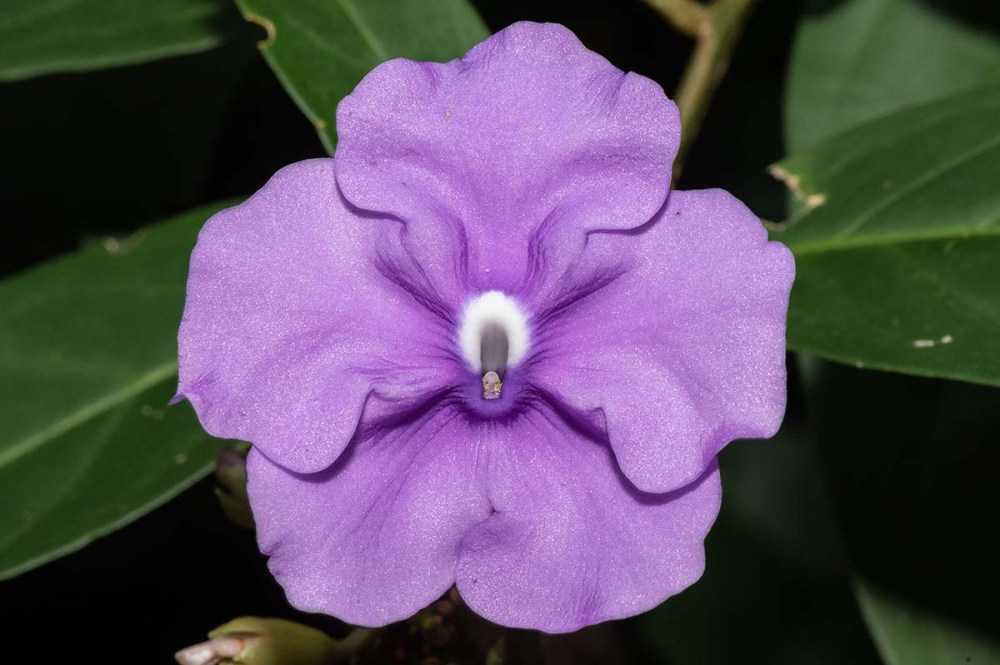
Yesterday, Today, Tomorrow, (Brunfelsia grandifolia). Flower
Yesterday, Today and Tomorrow is native to the northern part of South America. It belongs in the nightshade family; Solanaceae. It is planted in many Costa Rican gardens to provide a showy display of changing colors. The flowers are also fragrant and attract bees.
Color Sensitive
Many people are familiar with the Sensitive Plant, (Mimosa pudica). It has the entertaining habit of closing its leaves on contact or as night falls. It is a very low growing plant found sprawling along the edges of paths and roads. It is a native to Costa Rica but has now been naturalized in many tropical areas around the world.
The short-lived flowers are a deep lilac fused with red and are pollinated by bees. But the most intriguing thing about the Sensitive Plant is the ability of the leaves to fold up. At night the plant exhibits a behavior known as nyctinastic movement. As the sun sets are darkness envelopes the forest, the leaves of the Sensitive Plant fold and close together. As the sun rises, they open up again.
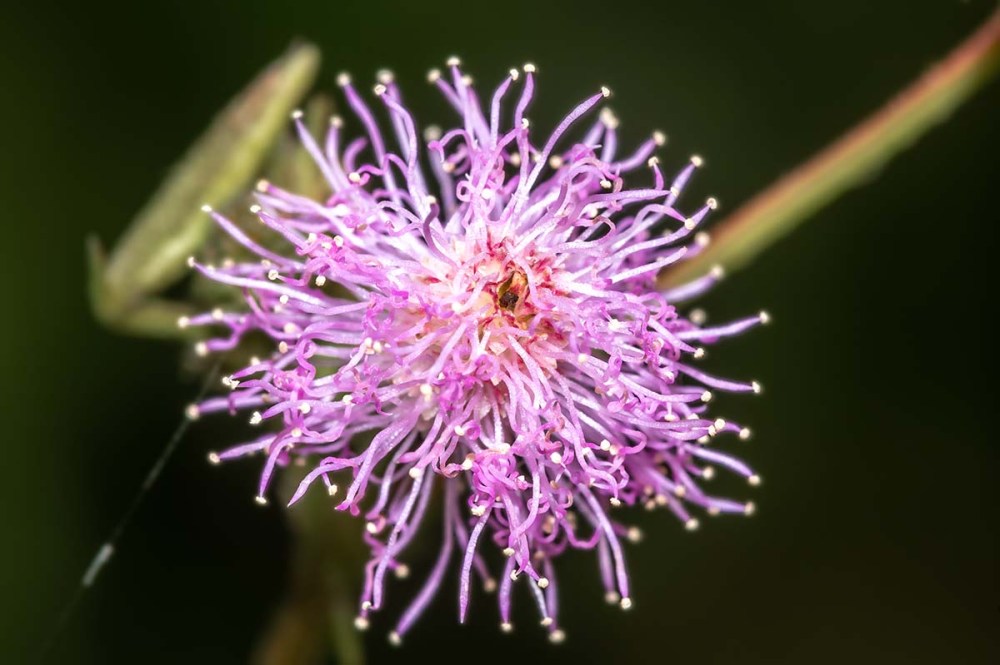
Sensitive Plant, (Mimosa pudica). Flower
But more familiarly, if touched the leaves immediately close, a phenomenon known as seisonastic movement. The means by which this happens is fascinating. Contact with the leaf causes an electronic impulse to be passed along the leaf which in turn stimulates the transfer of potassium out of the cells at the base of the leaf which then lose water and become flaccid and collapse. This is an energy expensive reaction from the plant to external contact and therefore must convey some benefit. As of now, we are not entirely sure what this benefit is. It could well be that it makes the leaf less appealing to herbivores or when it rains reduces potential damage by being smashed against the ground. Whatever the reason it certainly compels people to tap it and watch the response.
The Sensitive Plant is also an important nitrogen fixer. It releases a compound from its roots that inhibit certain pathogenic fungi growing near its roots. The roots have nodules which contain nitrogen fixing bacteria. The bacteria do something the plant cannot, they take atmospheric nitrogen and convert it into a form usable by the plant. Plants require nitrogen for many aspects of their lives, not the least of which being the growth of tissue. Up to 60% of the Sensitive Plant’s nitrogen requirement is provided by the root-dwelling bacteria which allow it to thrive in areas where the soils are nitrogen deficient.
Purple Rain: Lavender and Lilac Light Up The Forest
There are several other small herbaceous plants that can be seen on the forest floor or around the gardens that have lavender or purple coloration. Here and there an isolated small purple bell-shaped flower can be found. The small bloom stands out in contrast to the deep green of the surrounding vegetation. This is Monopyle sp of the family: Gesneriaceae. Growing in the same localities but with a larger, shrubbier aspect is the Portaweed, (Staphytarpheta frantzii), which is in the family: Verbenaceae. The butterflies, particularly skippers, seem to be attracted to the Portaweed flowers. Both of these plants are native to Costa Rica.
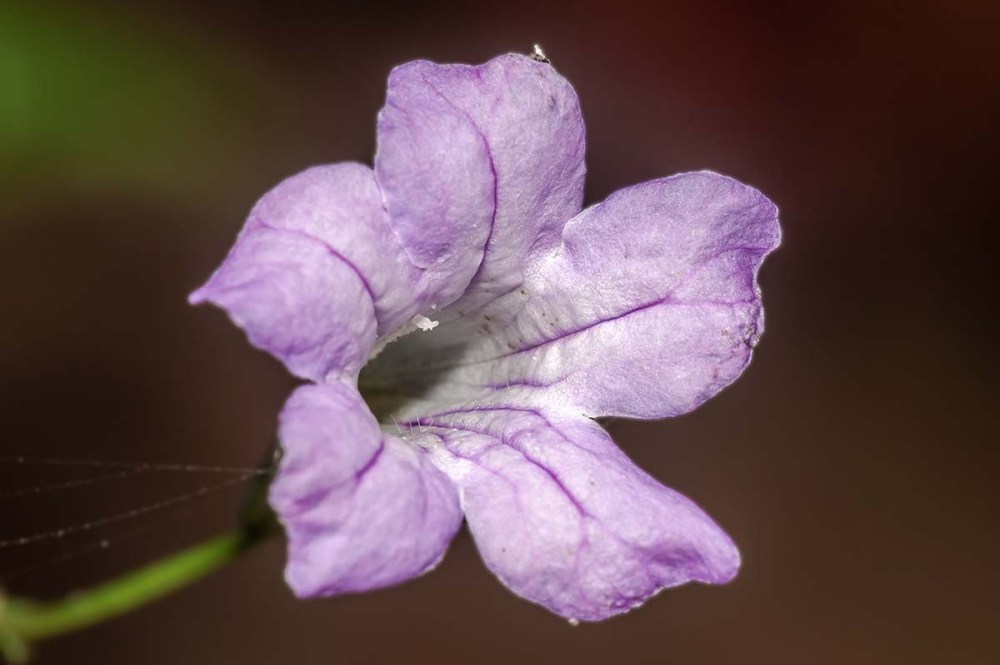
Monopyle sp. Flower.
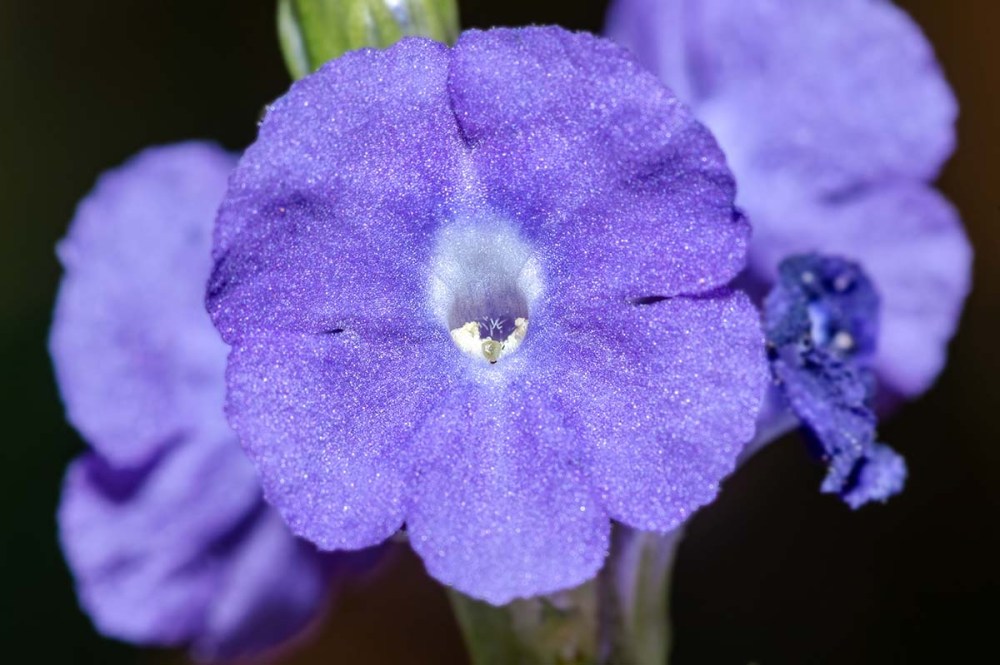
Portaweed, (Stachytapheta frantzii). Flower
Whereas both of the above plants are low growing and herbaceous, there is a tree that produces a spectacular display of flowers in the canopy, so much so that they are planted in Costa Rican town streets for their attractive blaze of color. These are the Jacarandas. When the flowers finish blooming they fall to the ground and cover the forest floor in a carpet of purple. A native Jacaranda in the forests of the Osa Peninsula is Jacaranda copaia, family: Bignoniaceae. When it does flower, the canopy is enriched with its pigmented presence. Afterwards, it provides a brief but colorful change to the normally dull red mud of the forest trails.

Jacaranda, (Jacaranda copeia). Flower.
Too Blue To Be True
Flowers tend to divide into 3 distinct classes with regard to color; red, orange and yellow or pink, lilac and lavender or white, cream and green. The different colors favor different types of pollinators. Red, orange and yellow attract birds, namely hummingbirds, pink, lilac and lavender are visited by insects, particularly bees, finally whites, creams and greens normally have nocturnal pollinators such as bats and hawkmoths.
The different colors are produced by different pigments. Plant pigments fall into four categories. Chlorophyll is a name most people will be familiar with, certainly to some level. It is responsible for the vitally important green coloration of plants. Carotenoids give rich reds, oranges and yellows. Flavonoids give the deep red/purples as well as blacks, browns and white. Betalains produce red/violet and orange/red. Things are not as simple as outlined above as there are many overlapping shades and hues.
The one color noticeable by its absence is blue. Blue is not a common color in plants or animals. Less than 10% of the named 280,000 species of flowering plants are blue in color. Plants that have blue flowers have done so with a little bit of manipulative trickery because there is no true blue pigment found in plants. Anthocyanins are a flavonoid pigment responsible for many red flowers and fruits. By mixing some of the pigments and altering the pH a blue color is produced. This produces some spectacular blooms such as Bluebells, Delphiniums and Morning Glory.
Day by day the rains lessen. Day by day the sun is breaking through a little more, warming up the ground and consequently the air. Evaporation causes the relative humidity to rise. We are almost there, almost into the dry season. It won’t be long before we start to lament the lack of precipitation but let us at least enjoy the first few dry weeks without complaint. There have now been 3 dry sunny days in succession. It doesn’t take long for the muddy trails to start drying out.
Biodiversity Most Ordinary: Net-winged Planthopper
There are certain insects that you see regularly in a variety of locations but they don’t excite your interest because there is nothing outstanding about them; no bright color, no unusual shape or weird behavior. They are just a general insect.
Net-winged Planthoppers fall into this category of ordinary. I see them but I am never inspired to point the lens in their direction. Last week as I was searching the vegetation, scrutinizing the grass blades and poking around on the ground looking for a subject that I may have never seen before, one of the Net-winged Planthoppers landed in front of me. Well here was an opportunity to photograph something even if the subject was mundane.
I am probably doing the Net-winged Planthopper a disservice as they are as important as everything else within the complex system of interactions that make up the tropical rainforest ecosystem. They are true bugs and belong in the homopteran family: Nogodinidae, which taxonomically is regarded as being Neotropical. Information regarding their life histories are non-existent at worst to scarce at best. I think this individual is one of the 3 known Biollyana species, possibly Biolleyana costalis. They are plant sap feeders and use the long piercing mouthparts to tap into the plant’s vascular system.
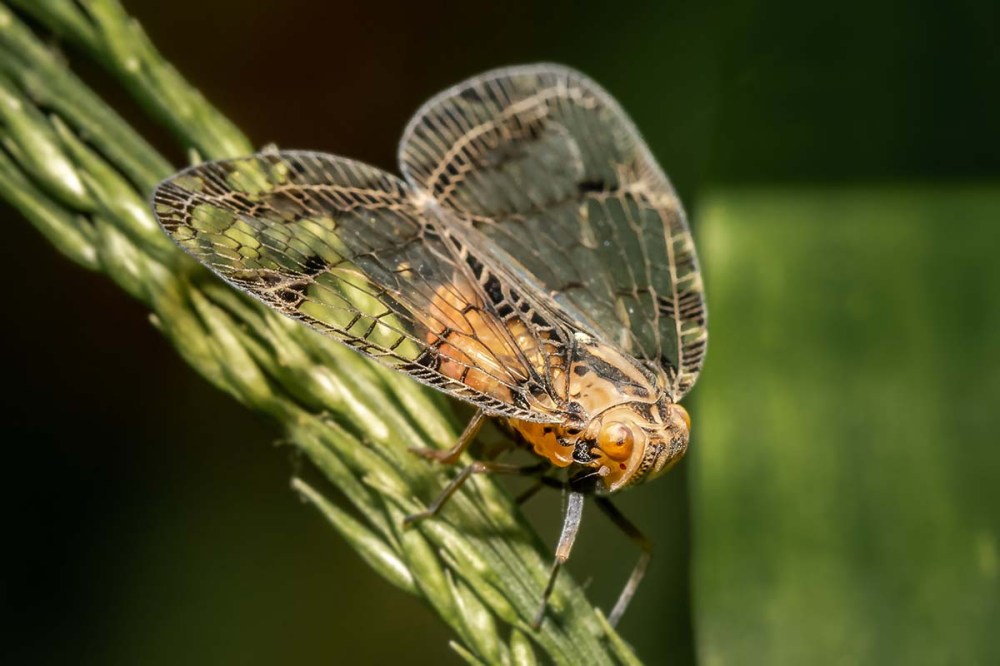
Net-winged Planthopper, (Bolleyana costalis)
There are 22 families of planthoppers consisting of approximately 12, 500 species. Despite their method of feeding, very few of them are vectors for plant borne diseases and are not especially known as agricultural pests.
Biodiversity Most Ordinary: Better Red Than Dead
Not too far from the Net-winged Planthopper I found another puzzling creature. My initial thought was that this is a Hemipteran nymph, probably Heteroptera but as to what family I do not know.
What caught my eye was the fact that this nymph was colored fiery red and I found it on a bright red Heliconia flower. This invites certain questions. Red is a commonly found color used by plants for their flowers in a tropical rainforest. Red is the complementary color to green. It is a very hot color whereas green is very cool color. Red will vividly stand out from a surrounding sea of green vegetation. Many pollinators have acute color vision and will spot the potential food source, (normally nectar), advertised by the plant. The payback is the transference of pollen and therefore the completion of reproduction for the stationary plant.
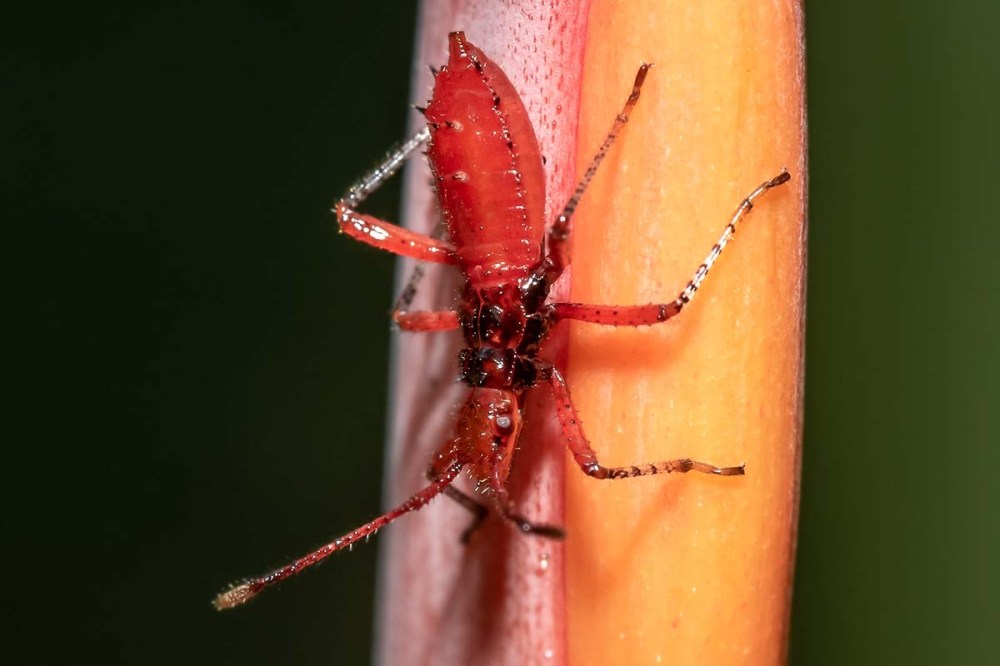
Flag-legged Bug Nymph
So does the adult bug select for red flowers on which to lay its eggs and the sap-sucking nymph that hatches is red and blends in with its host plant? Might it be that the nymph upon hatching feeds on the plant tissue and takes in the plants red pigments such as carotenes, which it then stores to subsequently give it the matching color? It may well be that is was simply a coincidence and the red nymph just happened to be on a red flower, there are many red heteropteran nymphs that feed on green leaves which defies logic as they then become very visible. But nature has its ways, which unlike the red nymphs on green leaves, is not always obvious.
Biodiversity Most Ordinary: Tales of the Flesh
Flies are distained by most people, and with good reason; they can be both annoying and dangerous. For the most part, flies possess wings, atypical for insects – only one pair of wings. Adult flies are liquid feeders and that embraces just about all liquids, including blood, particularly vertebrate blood. The larvae feed on liquids and solids.
Excellent fliers with unspeakably bad habits, (from a human point of view), and the ability to travel over long distances give the Diptera, (True Flies), a reputation as one of the most serious vectors of human borne disease and pathogens.
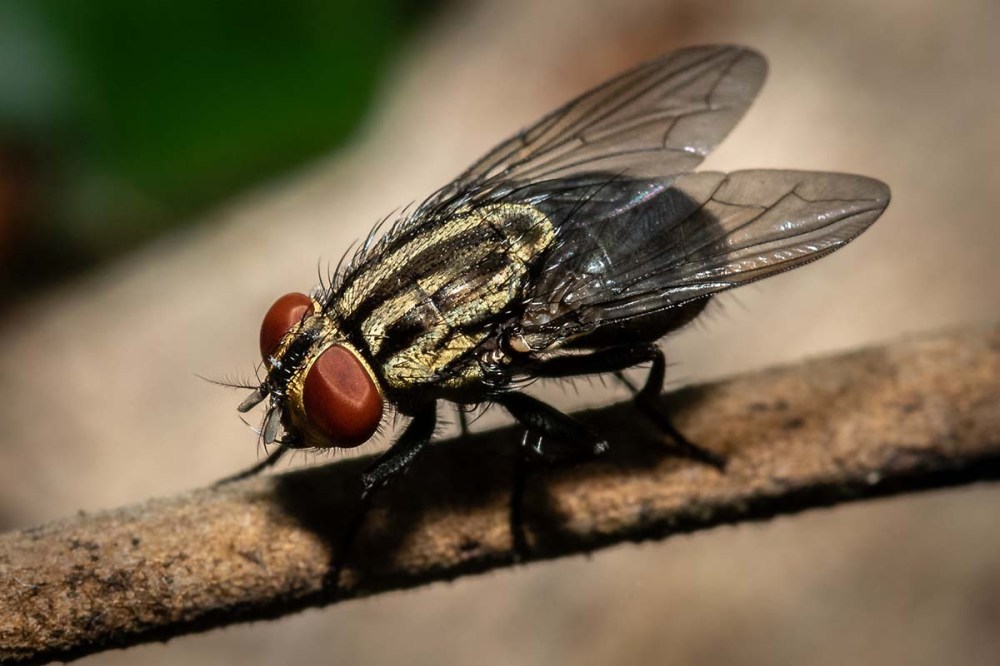
Flesh Fly, (Sarcophagidae sp)
Flies require protein in their diet, a first-rate source of which is blood, mammalian blood, human blood. Mosquitoes are probably the most widely know vectors used by blood living parasites as vectors between species and individuals within a species. Mosquitoes are not alone, they are joined by Black Flies, Sand Flies and Horse Flies as bringing nuisance, illness and death to their victims.
This Flesh Fly, (Sarcophagidae sp), was perched on a log in the sun. Flesh Flies could be regarded as a typical dipteran, to look at there is nothing outstanding. They are not particularly large or have strange anatomical features. There are about 600 species of Flesh Flies in the neotropics and to the layman they mostly all look the same.
Because they are common and widespread, their unsavory habit of feeding on carrion and excrement as well as associating with humans points the finger of accusation in being the mechanical vector in disease transmission. Unlike most dipterans Flesh Flies are ovoviviparous, the larvae hatch from the eggs as they are laid. In some cases this may be an open wound in a mammal where the maggot immediately begins to consume the rotting tissue, hence the name Flesh Fly. Who knows what this individual might have been carrying on its feet and liquid feeding tongue but I was never going to get close enough to find out.
There is still no let up in the rainy conditions. The good news is that the days are more overcast than dark and the rain is now falling more as a drizzle rather than a deluge. As with recent weeks the sun has been shining once in a while so hopefully as we move into December the rains will abate and we will be able to say the dry season has started.
Rainforest Diversity – Beetles
The wet conditions have kept me indoors more than I would like. On those occasions that I have been out and about there was not too much animal life to point the camera at. When you read about the diversity of fauna and flora contained within a tropical rainforest you would expect to be surrounded by a non-stop progression of subjects. That is not always the case. However if you persist and concentrate on looking a little more closely at the vegetation then something is bound to turn up.
Beetles are the most numerously named group of animals on the planet. Surely there have to be beetles wherever you look. Well they aren’t as obvious as you might imagine. Many of them are secretive, ground-living or wood-boring insects. Looking diligently at the leaves as I made my way along a sunny path and hoping for at least one or two individuals of any insect to be out I saw a small beetle that I had never seen before. Given that Costa Rica has 47,000 named species of beetle and I would never profess to being a specialist coleopterist, then the fact that I did not know what species I was looking at should come as no surprise.
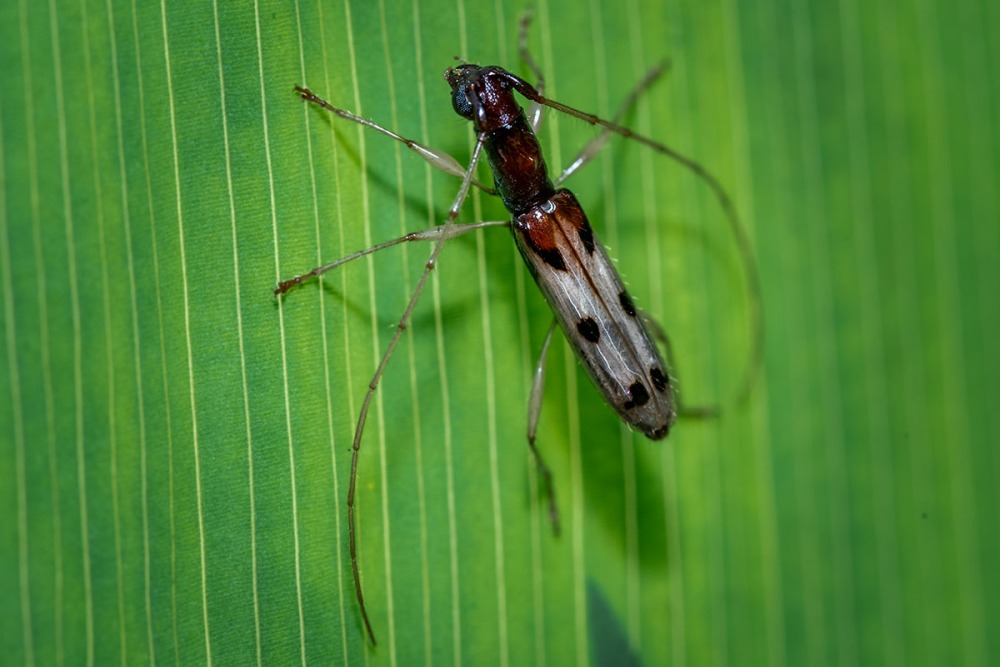
Long-horned Beetle, (Family: Cerambycidae)
I can generally make an immediate I.D. to family level and that was not hard with this one. The length of the antennae were the give away, the very long length, far longer than the body. This was a small Long-horned Beetle, family: Cerambycidae. This one also had a long pronotum, (the area behind the head), and a very long body. I was guessing it belonged in the subfamily: Cerambycinae. I now had to go and research online to see if I could find the genus and species. Alas, my scrutinizing a great many photographs failed to result in a match but at least I have the image should I find further reference material in the future.
Rainforest Diversity – Fungi
The beetles are matched by the fungi in terms of numbers and also a lack of reference material for the non-specialist to identify them to species level. Many of the biologists working with tropical taxa tend to be specialists. I am more of a generalist and enjoy all forms of life; plants, animals, fungi and no matter whether they are extant or extinct. My areas of specialty are butterflies, reptiles and amphibians. It can be frustrating sometimes when a name cannot be found as that might reveal information about the life-history of the organism and its role in the ecosystem. Essentially it helps establish those links that increase our understanding of the system, what happens if those links are severed and conservation management strategies that would be required to stop the system collapsing.
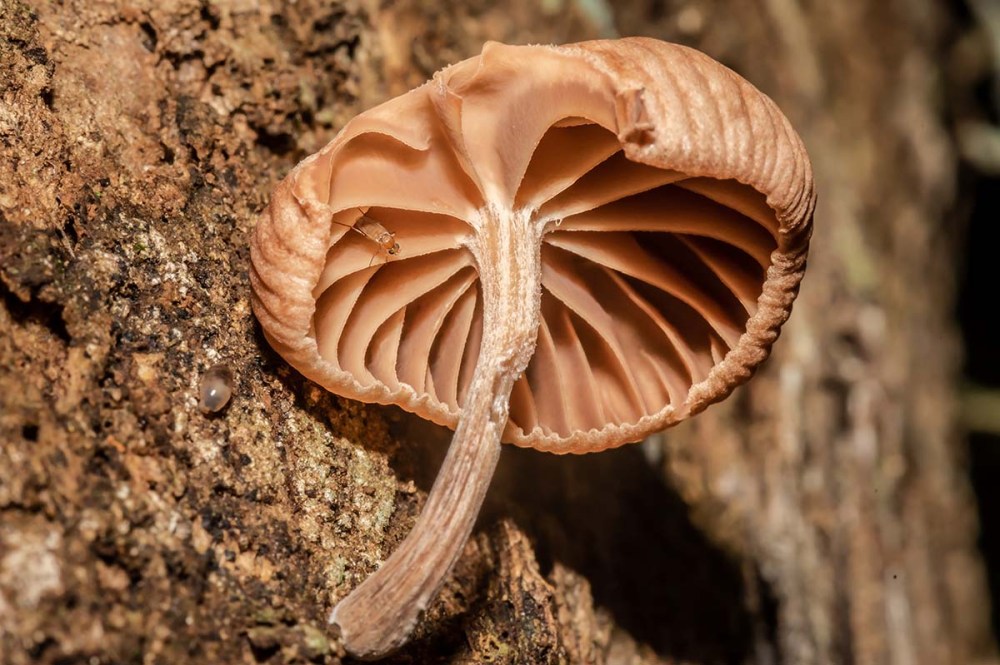
Hygrocybe sp
So it was that I found a mushroom growing from the side of a rotten tree trunk. I had seen and photographed this species before and, like so many others, had not been abled to identify it to species level. There are 2000 named species of fungi in Costa Rica but estimates of how many species actually exist in this small country are as high as 70 000, so you can see the problem, you may be looking at one of the 68 000 estimated species that have not as yet been discovered.
This specimen was somewhat dried out and partly eaten. The aspect gives a good view of the gills under the cap. Given the features I have to work with I would guess the genus to be Hygrocybe, but I would not be held to that. Within the gills you can also see a fungus fly. These are flies that lay their eggs in the mushroom and when the larvae emerge they are surrounded by a ready food supply.
Rainforest Diversity – Spiders
Spiders are the eighth most numerously named group of animals on the planet. As with the beetles and fungi, reference material is sparse for Costa Rican species. However, this was one I did know. It is not an uncommon spider. They are nocturnal and build very distinctive horizontal webs. It is an Orchard Spider, (Leucauge venusta).
They are not large spiders and can be easily overlooked. But if you get up close you will find it has rather lovely markings. The opisthosoma is patterned with curving bands colored with white, red, yellow and blue.
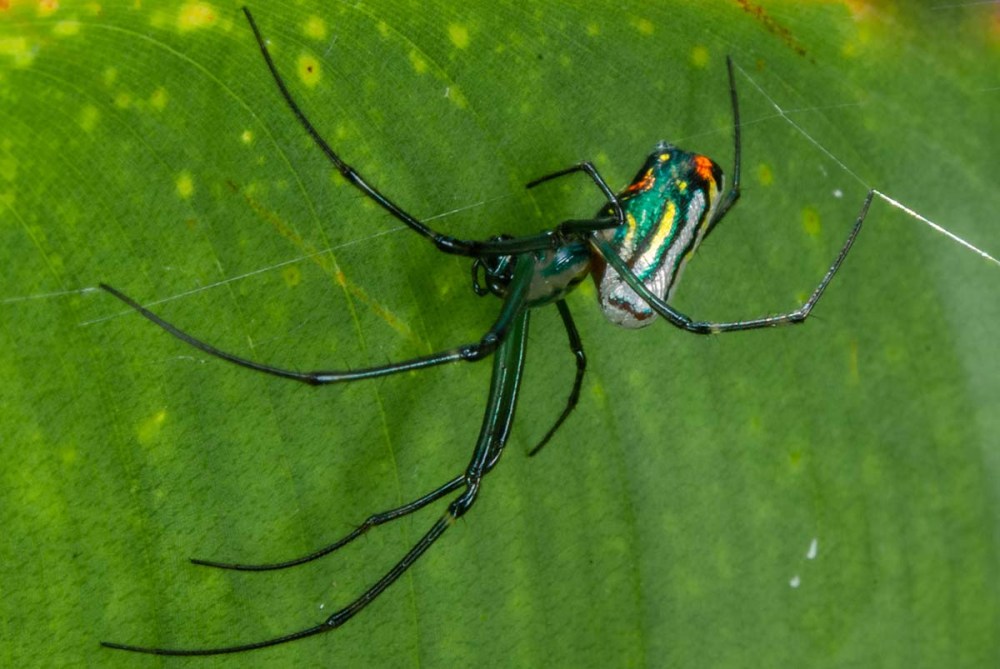
Orcha)rd Spider, (Leucauge venusta
Orchard Spiders are prone to being parasitized by Ichneumonid Wasps. The wasp finds the spider and injects an egg into its abdomen. The egg hatches and the wasp larva proceeds to suck the spider’s internal bodily fluids. Outwardly this does not seem to affect the spider’s behavior and it continues web building as normal. But then something insidious happens. The wasp larva produces a chemical that allows it to sequester the spiders brain. The chemical changes the spiders web building behavior and it produces a web which is not conducive to capturing insects but rather acts as a protective silken home for the pupating wasp. The zombified spider, now of no value to the wasp, dies. Nature can be both cruel and fascinating at the same time.
Rainforest Diversity – Butterflies
For someone passionate about butterflies I am in the right country. Rainforests cover 6% the total land surface of the Earth and yet contain an estimated 50% of the worlds biodiversity. Costa Rica, with only 0.3% of the planets terrestrial area is estimated to house 5% of the world’s total biodiversity. The Osa Peninsula in the south west of the country is one of the most biodiverse localities in Costa Rica. There are a lot of butterflies here. I have recorded approximately 400 of the 1250 species to be found in this small Central American Republic, that is 32% found at Cabo Matapalo, the tip of this tiny piece of land sticking out into the Pacific Ocean.
Even here on Cabo Matapalo there is a large diversity of habitat and different butterflies prefer different conditions. Many of the butterflies live up at canopy level and are beyond daily recording techniques. There are butterflies that prefer open sunny gardened areas, some can be more commonly found along forest edges. Then there are those presence will only be recorded in the gloomy and shadowy world that exists beneath the canopy, some at higher levels and some always hugging the ground.
I have nothing against bright, gaudy coloration but my liking is for more cryptic and subtle forms which when examined close up are every bit as beautiful as their showy cousins. Among the more subdued colored butterflies are the Browns or Satyrs belonging to the family: Nymphalidae, subfamily: Satyrinae. The Satyrinae are notable for the number of eyespots on the underside of the wings. The ground colors are browns and grays patterned with ochres and umbers.

Two-band Satyr, (Pareuptychia ocirrhoe)
The Two-banded Satyr, (Pareuptychia ocrirrhoe), has white dorsal wing surfaces and a bouncy flight close to the ground which gives it a flickering appearance. I found this one flying along the forest edge on a very overcast day. They respond quickly to movement so you have to approach slowly and deliberately in order for them to stay perched.
The Two-banded Satyr is normally found singly. The larvae feed on grasses, (Poaceae), and the adults feed on rotting fruit and fungi, a diet that may account for them living longer, (several weeks), than other butterflies, (several days).
November is upon us. The wet season continues, relentless heavy rain falling if not all day then at least part thereof. One day last week over 14 inches of rain fall in an overnight deluge. The following day the forest trails were more akin to newly formed streams, the water flowing downhill until it reached a point where it could tumble into the main creek that runs through the grounds, swelling its volume and increasing its velocity to that of a raging torrent. There have been some dry, sunny days and if the weather continues its normal pattern then progressively as we move through the month the number of rainless days should increase.
I have been away for a month and upon my return, as with each and every year, the first thing I hear is the call of the Summer Tanager, (Piranga rubra), a migrant which has spent the summer in North America. Not much has changed in the area while I was away. The resident wildlife can still be found without any effort. The White-nosed Coati, (Nasua narica), populations are growing at a steady and sustained rate. I have never seen as many wandering the grounds as I do now. The solitary males are normally bold creatures, but the females tend to be shy and retiring. Now, however, the females and their young will allow you to approach very close without scurrying off into the shelter of the trees as they did in the past.

Golfo Dulce Anolis Lizard, (Anolis osae)
The wet conditions have allowed the amphibians to continue their courtship and breeding. There are not so many egg masses present as in the main breeding period, (May – July), but there are still several species spawning on a nightly basis. Feeding on the frog eggs are the Cat-eyed Snakes, (Leptodeira septentrionalis), which can be found every night by the pond. The ever-present anoles of several species can be seen in the forest. The commonest and most obvious is the Osa Anole, (Anolis osae), with its bright orange dewlap. If one male is signaling to another to leave his territory then you can’t miss that fiery flash of color against the dark background.
Ants Are Everywhere
Ants are ubiquitous insects in the forest. On the trees you will see lines of Tiger Ants, (Camponotus sericeiventris), walking in line, foraging for food. They receive their name from the black and yellow coloration rather than an aggressive nature. In the lawns you would be well advised to avoid stepping in those small powdering mounds of earth that betray the presence of Fire Ants, (Solonopsis sp), living just beneath the surface. I have never known anything so small cause so much pain as the fire ants. The problem is that they are so small you don’t know you are covered in them until they start to bite and they all do so together. It would be almost impossible to miss the presence of Leaf-cutter Ants, (Atta cephalotes), in these forests, whether it be descending the tree trunks with freshly cut leaf fragments or seeing lines of ants moving as a green river, snaking across the forest floor as they make their way back to, the nests with, what essentially is composting material for their fungus gardens. Leaf-cutter Ant nests occur every 100 meters or so in whatever direction throughout the forest and can easily be identified by the large waste tips of excavated material marking the nests’ peripheral boundaries.
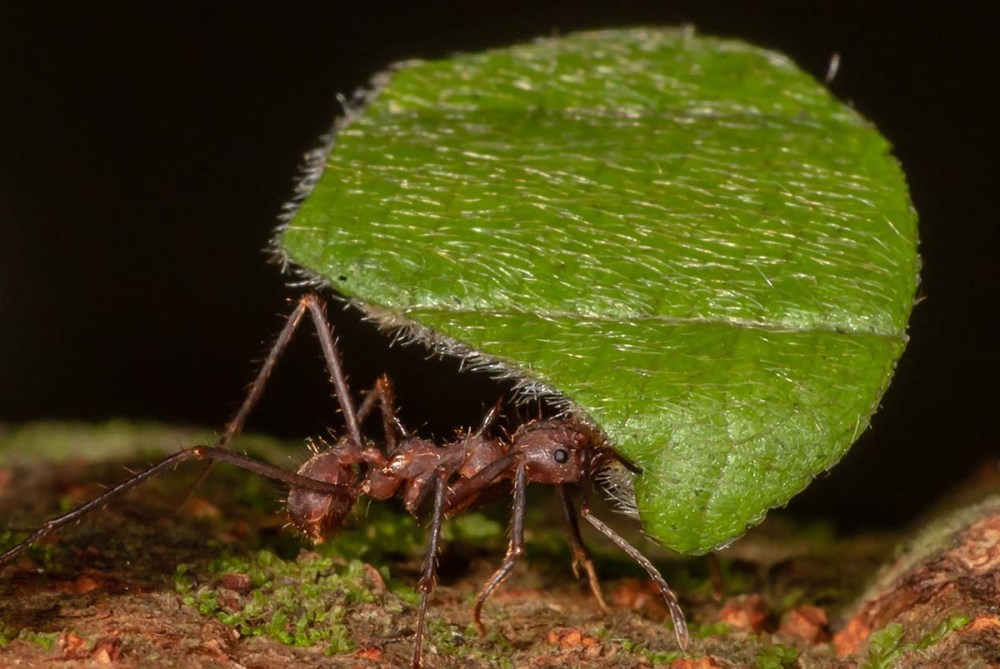
Leaf-cutter Ant (Atta cephalotes),, media caste carrying leaf fragment
Army Ants: A Living Wave of Black Death
It is a warm day, the rain has stopped, the sun is shining and you are quietly walking through the forest, binoculars strung around your neck and camera in hand. The air is still and there is little sound bar the occasional call of a bird here and there and the soft white noise of calling insects which is not too intrusive. You walk in a state of reverie, not thinking about anything in particular, your eyes scanning the vegetation for small subjects to photograph or watching for movement that may indicate a bird or mammal is moving across your path. It is a day for enjoying your surroundings and contemplating the life contained within. You are blissfully unaware of the carnage being carried out in the forest ahead.

Army Ants, (Echiton burchellii)
As you make your way forward you start to hear more birds calling. Some of the sounds you are familiar with; a Black-hooded Antshrike, (Thamnophilus bridgesi), Bicolored Antbirds, (Gymnophythis leucaspis), and Chestnut-backed Antbirds, (Myrmeciza exul). This seems as if it might provide some good photographic opportunities so you make sure the camera is ready with the correct settings. Now some other birds fly past you and land on the tree trunks, most of them a variety of treecreepers; Streak-headed, (Lepidocolaptes souleyetii), Tawny-winged, (Dendrocincla anabatina), and Ruddy, (Dendrocinclo homochroa). The bird calls are increasing in intensity, excitement and volume as you make your way to where they seem to be congregating. As you approach you can see them briefy dropping from the vegetation to the ground and back up again. There is another sound, a hum which pervades the air. Having left your dreamlike state and become more acutely aware you see that you are surrounded by flies buzzing everywhere. You see one or two Gray-headed Tanagers, (Eucomectis penicillata), amongst the mixed bird flock, the presence of which along with the flies provide the clues as to what is happening. Finally you hear, a sound like softly falling rain and yet there is not a cloud in the sky. From about 5 meters in front of you and advancing rapidly towards you like a sheet of black polythene being pulled across the forest floor is a foraging front of Army Ants, (Echiton burchellii); a living wave of black death.
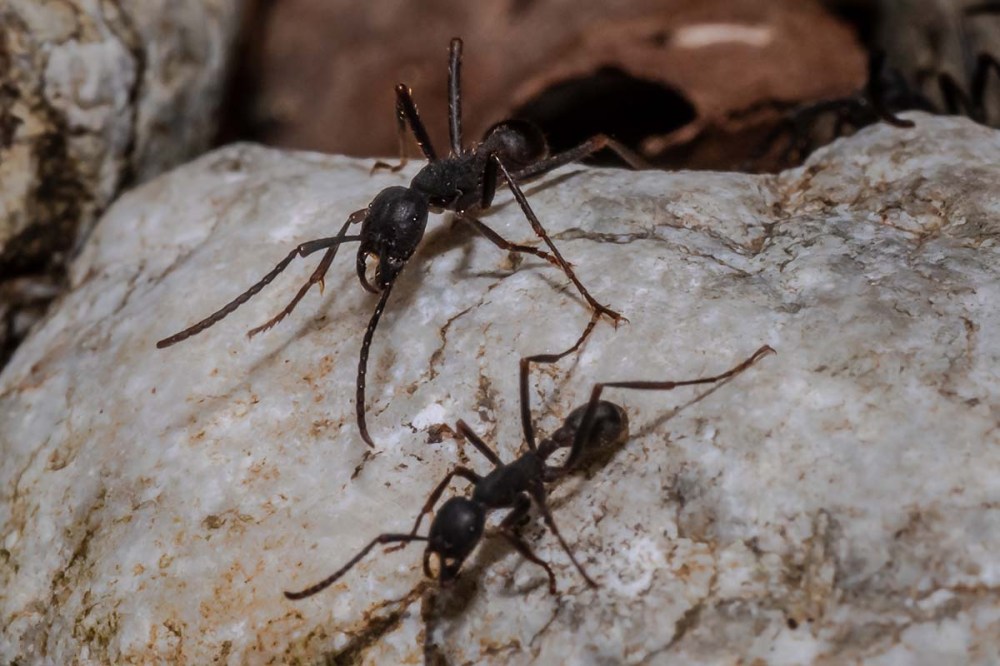
Army Ants, (Eciton burchellii), on the move
The feet of thousands of miniature assassins moving as one across the dried leaves give the illusion of rain falling. You stand dumbstruck by the scene playing out in front of you. As the procession of annihilation moves closer you can see down by your feet beetles, cockroaches and crickets running for their lives. These are the lucky few. The killers are insatiable. Any small creature unfortunate enough to caught in their unrelenting path will be overwhelmed, stung to death, and then decapitated, dismembered and disemboweled. The wickedly sharp mandibles of the army ant hunters slash and cut through exoskeleton, muscle and connective tissue. The victim’s mutilated body fragments are then carried away by the mindless insect ghouls to provide a feast macabre for the larvae. As fascinating to witness as this bloodbath at the macro level is, you had better move. The ants are now crossing the path all around your feet. You might be too big for them to tackle, but the long stinger and virulent toxin can cause a lot of pain.
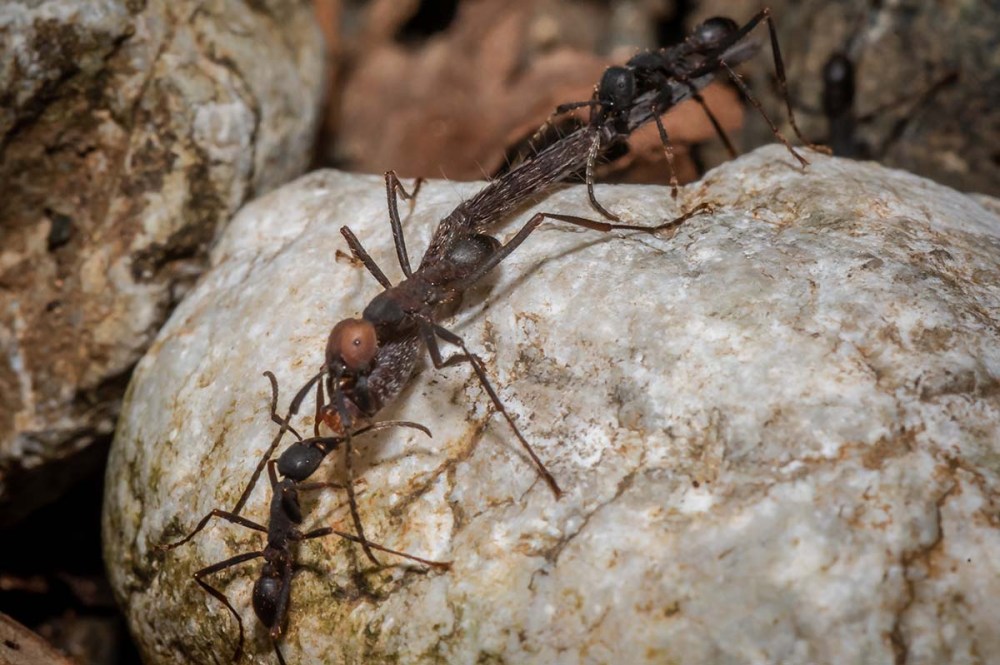
Army Ants, (Eciton burchellii), carrying dismembered spider leg
For those insects capable of flight and able to escape the ravaging mandibles of the ants, the danger is not over. The birds were attracted to the ant swarm to take advantage of the free meal they provide by flushing insects from their hiding places. Gray-headed Tanagers are obligative followers of the army ants. Wherever they are, you will find the tanagers. The flies are there for the same reason. These are Coffin Flies, (Phoridae sp). When an insect attempts to escape by taking flight, the parasitic phorid fly swoops in, lays an egg and flies out again. The eggs will hatch and the grub will eat the victim.
Army Ants are one of the major predators in the forest. They rank alongside Boa Constrictors, Harpy Eagles and Jaguars as one of the top of the food pyramid predators in the forest. They are a nomadic ant and they have to be nomadic because being such a super-efficient predator, should they settle in any one area for any length of time, they would deplete it of all small forms of life very quickly.
They have 2 three week cycles; a nomadic stage when they move in a flowing column of ants, the queen travelling with them, until they find a new hunting ground. They do not construct a nest, they make a bivouac, generally at the base of a tree, which is a huge ball of ants held together by the interlinking of legs. The queen moves to center and swells up. She starts to lay approx. 60, 000 eggs per day. When the eggs hatch and the larvae emerge, the emit a pheromone which elicits a hunting response from the other workers. They then move through the forest in a front anything up to 60 feet, (20 meters), across and take all small forms of life in their path: insects, small frogs, small lizards, small snakes, fledgling birds, if it is there then they will have it. Once it has been butchered into small pieces, these are taken back via feeder columns to the bivouac to feed the larvae. When the larvae pupate, the hunting response is switched off and they return to the nomadic stage making their way through the forest once again.
A New Assassin
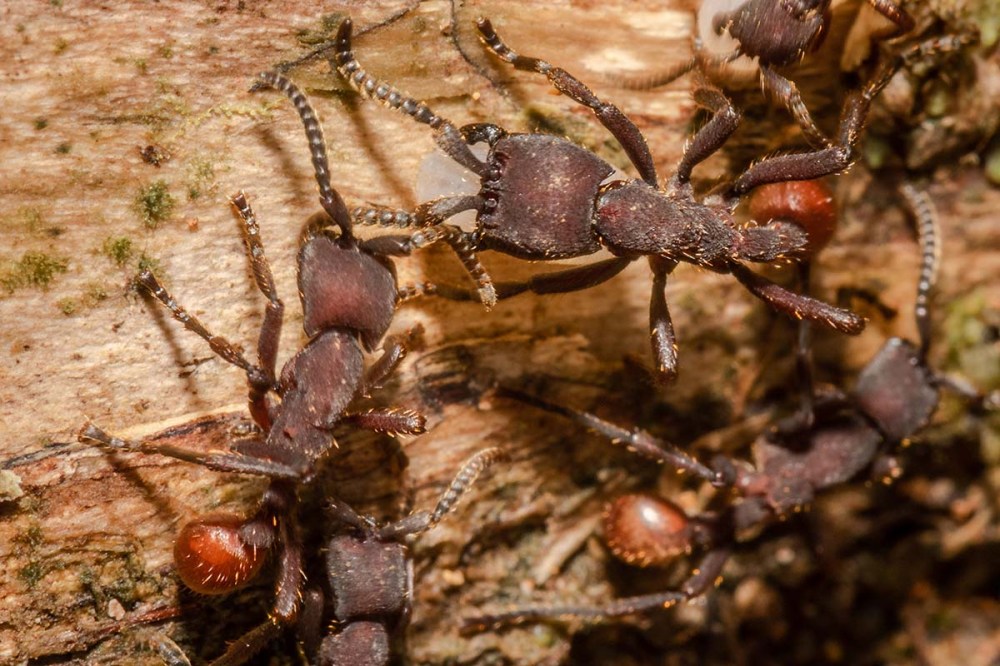
Army Ants, (Nomamyrmex sp), taking larvae from a Leaf-cutter Ant nest.
There are many species of Army Ant and the species described above is the most commonly found in the area Echiton burchellii. Last week I found a species that I had never seen before. As well as slaughtering prey items on the forest floor, army ants will also enter the nests of other ants and take out the eggs, larvae, pupae, workers and queen. The one ant they fight shy of taking on are the Leaf-cutter Ants. There may be several hundred thousand in an army ant colony, there can be up to 8 million in a leaf-cutter ant colony. The soldier leaf-cutters are huge and equipped with razor sharp mandibles. They are programmed to fight to the death. The army ants would lose so many of their own numbers if they were to raid a leaf-cutter ant nest. Even if they come across them on a trail they will not interfere with them.

A rare sight, Army Ants raid Leaf-cutter Ant nest
It was to my surprise therefore when last week a watched for the first time an army ant raid on a leaf-cutter ant nest. Luckily I had the camera in my hand and found a place to lie down and take photos. On this occasion the leaf-cutters seemed to be helpless to stop the nest being ransacked. When I downloaded the images and looked at the images I did not recognize the species at all. Despite their distinctive flat, square heads, extensive searching produced no I.D. Eventually I found one photo and some information. The genus is Nomamyrmex and it contains two species. I am not sure which one I had been watching but I was happy to have witnessed an event I had never seen before being carried out by an ant I had never seen before and had the photos to prove it.
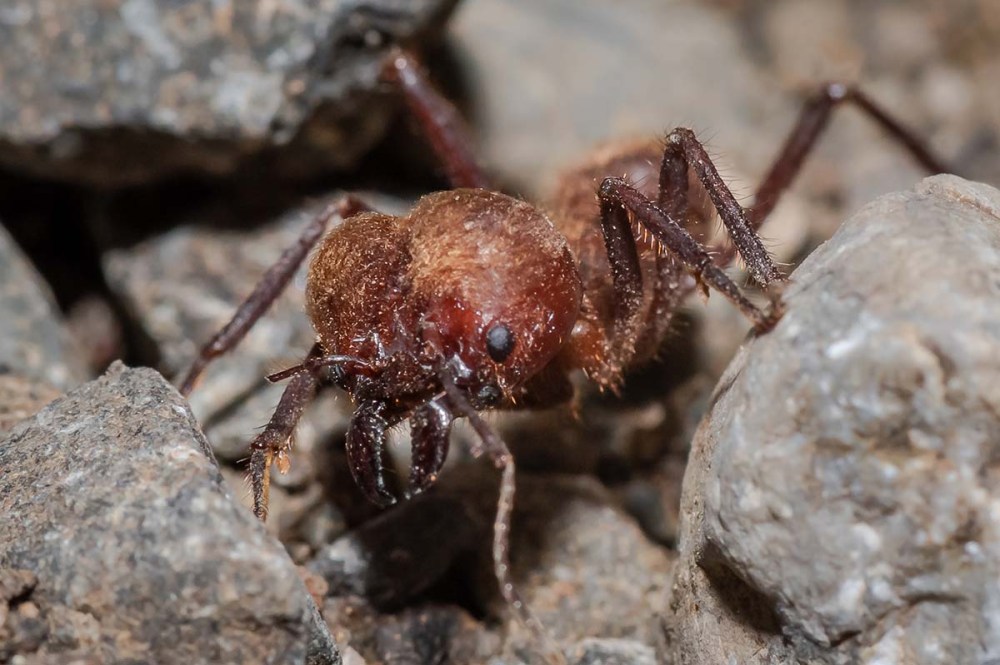
Leaf-cutter-Ant, (Atta cephalotes). Maxima caste
Now the weather has taken a significant change. The rains that are expected to fall in September have started in earnest. The rain is now falling all day and on most days. This is good news for the frogs and this year the breeding continues on without a drop in intensity. Every night there are large numbers of calling males. The females are obviously responding because every morning there are lots of freshly spawned eggs.
After 17 years of data collection for my study, “Using amphibian and butterfly populations as a measure of environmental health”, I have decided to call it a day and now have to sit down and analyze the data. Essentially I have been collecting data on population dynamics of butterflies and amphibians as well as recording daily weather conditions. I look at changes in butterfly populations measured against temperature and amphibian populations measured against precipitation. Over seventeen years the temperatures have continued to rise in a linear fashion and the number of butterfly species have dropped dramatically. I now have to try and figure out why.
Butterflies in the Sun
Due to the constant rain and the trails running like streams, I have not been able to spend as much time outside as I would normally wish. However, on the one day I did manage to get out and take some photographs I was rewarded with a mixed bag of goodies of which only one was new to me.
One morning the sun was shining and the butterflies were taking advantage of its warming rays. The Lantana camara bushes are always a big nectar draw for the butterflies and this day proved to be no different. Although there were nowhere near the number of species found during drier periods of the year there were enough to try and take a few shots.
One very small but distinctive butterfly that I have a particular liking for, (I don’t know why), is the Tropical Checkered Skipper, (Pyrgus oileus). It is a fairly common skipper with a wide geographical distribution from southern North America and through into Costa Rica. At a distance the black and white checkered pattern make it stand out against the green of the grass where it is normally found flying close to the ground. When seen close up the wings and body are covered in a grey/blue fur. The females tend to be a darker overall color. The caterpillars feed on plants in the family: Malvaceae, of which there are several species growing in abundance locally.
They belong in the family: Hesperiidae and the subfamily: Pyrginae or Spreadwing Skippers due to their habit of basking with the wings wide open. There are approximately 50 species in the genus: Pyrgus and they can be found throughout Europe, Asia, North, Central and South America. You are more likely to find Tropical Checkered Skippers in open sunny locations which is where I found this one.
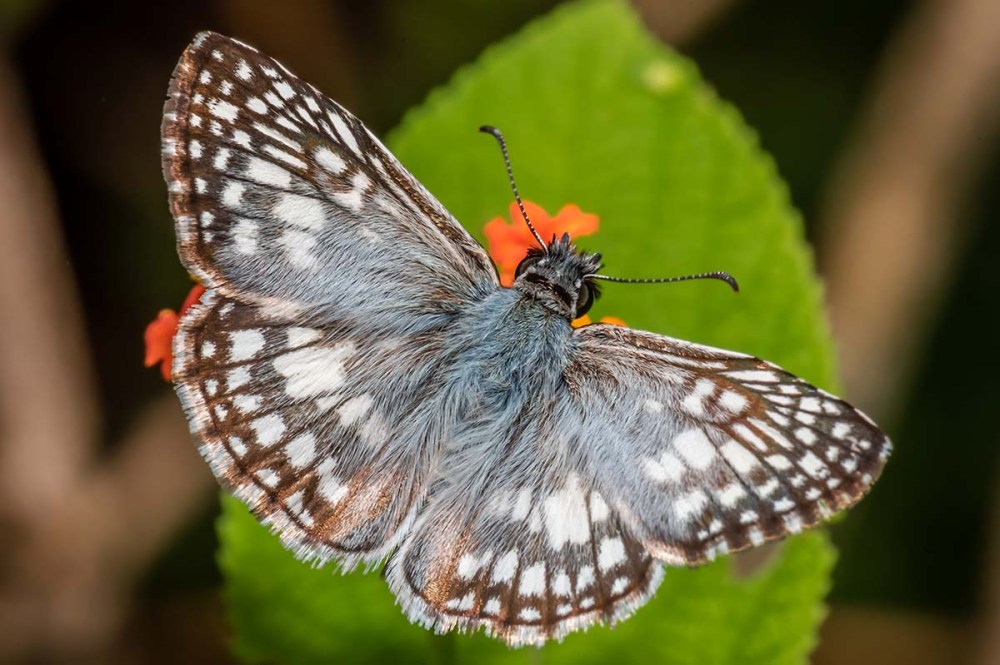
Tropical Checkered Skipper, (Pyrgus oileus)
Feeding on the nectar of the same patch of Lantana was yet another Spreadwing Skipper but one which looked completely different to the Checkered Skipper. This was a Plain Long-tailed Skipper, (Urbanus simplicius), notable for the two long tail-like extensions of the hind wings. There are several species of Long-tailed Skippers in the immediate area but each one has distinctive markings to the wings. The dorsal surface of the abdomen and the wings are covered in metallic green hairs. Again it is a widespread species ranging from southern North America, down through Central America and into South America. The larvae feed on leguminous vines of which there are many species growing locally. In North America it is sometimes considered a pest as it feeds on commercially grown beans.

Plain-Longtail, (Pyrgus simplicius)
This individual can be seen using its proboscis to probe for and suck nectar from the Lantana blooms. One of the changes I have documented over the past 17 years is the progressive increase in annual average temperatures. One of the impacts this may have on butterfly populations is with increasing temperatures there will be increasing evaporation of the nectar. This in turn causes an exponential increase in nectar viscosity. We could end up with a situation whereby if the temperature increases to the point where the nectar is too viscous for the butterflies to suck up, then they may well not be able to feed, bringing about starvation, death and a collapse in butterfly numbers. This is one of many variables I have to take into consideration when looking at the fact that we have had a 35% decline in butterfly species over the past 17 years.
Sweat Bees: Burnished Metal
While watching the butterflies flit back and forth, only stopping momentarily to take a feed of nectar, I noticed a tiny metallic green insect, only about 10mm long. It was on top of a leaf at eye level and not moving. It was striking in that the green was very reflective, it looked like a piece of metallic foil. I was looking at a Sweat Bee. I have only ever photographed one in the past so if this one did not move then here was a second opportunity beckoning. I slowly lifted the camera and got the shot but as I moved my position for a head on photo it took to the air and disappeared.
Sweat Bees are solitary bees of the order: Hymenoptera, which includes bees, wasps and ants amongst others. They belong in the family: Halictidae. The burnished metallic green certainly has a jewel-like quality. The refraction of light produces the spectacular metallic coloration, similar to the iridescent blues of the Blue Morpho butterflies. In this case it is the multi-layered waxy cuticle of the bees exoskeleton that produces the refraction. There are over 2,000 named species of Sweat Bee and they are found in most parts of the world.
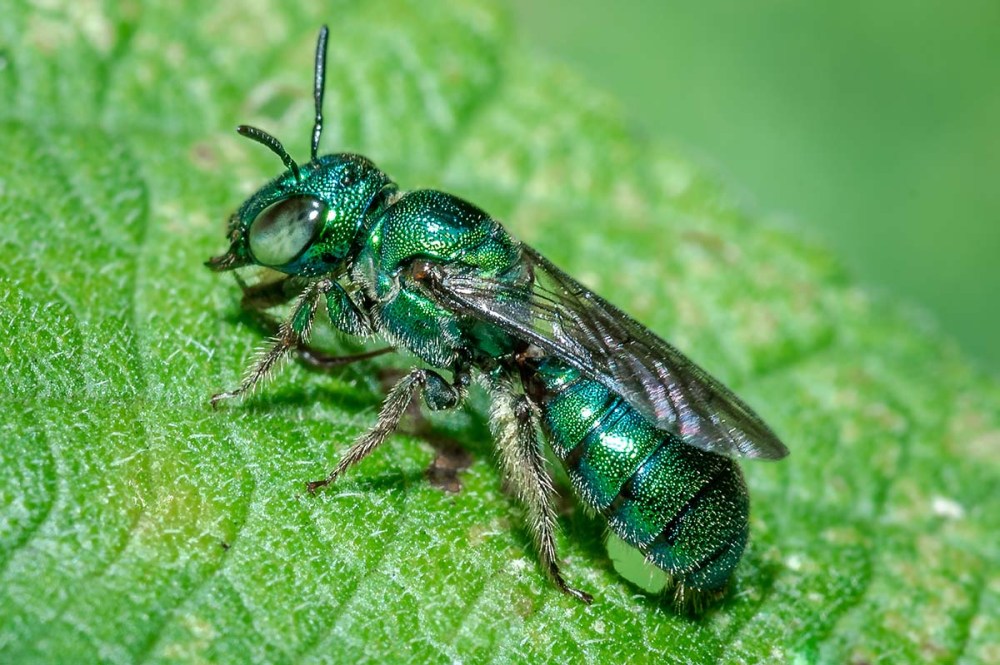
Sweat Bee, (Augochloropisis sp)
The name Sweat Bee refers to the fact that they will land on your perspiring skin to suck up the sweat for the salt it contains.
They are solitary bees and usually nest in the ground. The female creates a waxen cell then mass provisions it with pollen and nectar. An egg is laid and the cell capped so the larva can develop within. Once fully grown, it pupates, and finally emerges as an adult and leaves the mothers nest.
A Collection of Queens
A wasp nest that I have been walking past over the past month or so has been not only gradually increasing in size but is now populated by more adult wasps tending it. It is the nest of one of the Social Paper Wasps, (Polistes sp). The original queen had created a few cells beneath a leaf in each of which she laid an egg. The eggs hatched, the larvae she provided with a food of chewed up insects until they were large enough. She then capped the cell of the now pupa and waited for it to emerge. The new wasp is one of the original queen’s offspring and like their mother they are equally capable of mating and reproducing.
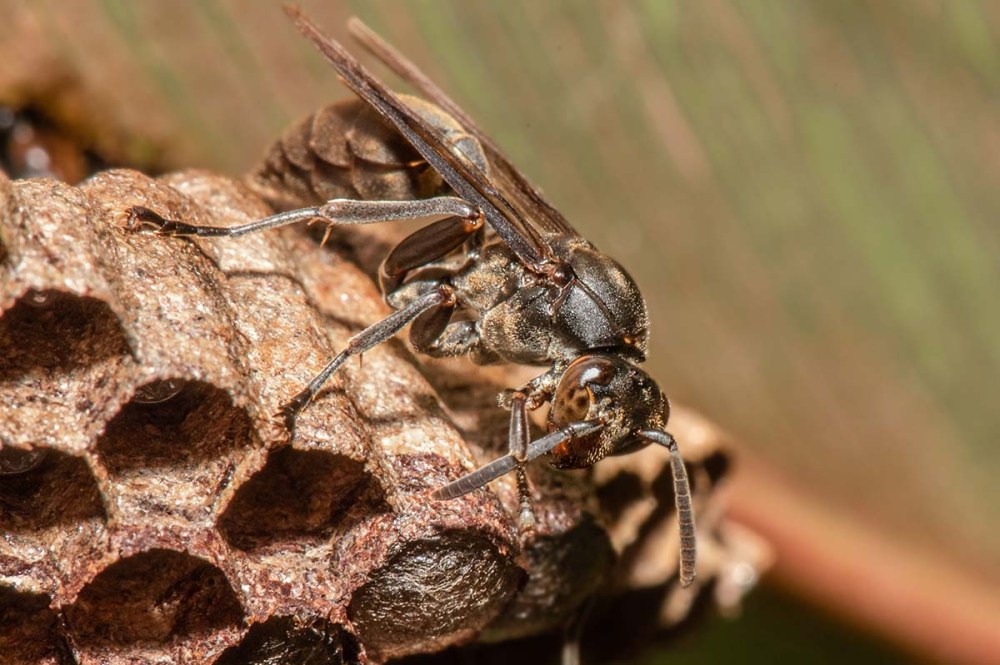
Paper Wasp, (Polistinae sp). Dominant female on nest
To begin with they help with the nest, building more cells, tending the larval siblings, foraging for food and helping the nest to increase in size. The cells are constructed from masticated vegetative material. Prey is caught and chewed up for the larvae to feed. The sting is only used defensively. They will attack any potential predator that approaches too close. So, my approach was one of great stealth. I took a few took a few exposures but the flash was beginning to antagonize them and one took flight and started buzzing around my head which was my cue to slowly back off and leave them to their business.
The other females usually have reduced ovarian systems but dominance of the original queen is not always assured. Fights break out and a new queen can become established within the hierarchy taking over the major reproductive role. When the male wasps emerge, they may stay on the nest for some time before leaving.
The weather is beginning to change. There are now more rainy days with brief intervals of sun, generally shining in the morning. Most of the nights are wet, with the rain beginning in the early hours of the evening then continuing through till dawn. The rain is not heavy but it is constant. This will now be the pattern until mid-November. The opportunities to get out and take photographs is going to become more and more limited as the days and weeks go by.
Ogre-faced Spider
Sometimes you just have to be lucky and find yourself in the right place at the right time. Many years ago I had taken some photographs of a particular species of spider and since then had been hoping to see this species again to get a close up of one of its startling features, the eyes. I have come across it several times over the years but, unfortunately, never when I was carrying the camera. Last week my luck changed and I found one without actually looking for it and I did have my camera in hand.
The spider in question is an Ogre-faced Spider, (Deinopis sp), of the family: Deinopidae. Once you see the spider in close up then the reason for the name will be revealed. Those two large, forward-facing eyes give the appearance of a mythical ogre staring at you.
The Ogre-faced spiders are not typical orb-weavers, they belong to a group known as lace-web weavers and have evolved a different means of employing silk to catch prey. There are only 57 species of Ogre-faced spiders but they are found throughout the tropics. They have long legs and a long abdomen, (opisthosoma). If they do move, it is slowly and deliberately. The coloration matches the tree bark on which they are commonly found hanging in a head down position. During the day they lie flat against the tree to avoid being seen. But as the sun sets they move into position and set about constructing the ingenious part of its prey capturing trap which is held between the front two pairs of legs.
These four legs have a dry silk frame strung between them. Attached to the frame is a net made from sticky elastic silk. An unsuspecting prey item passing below the spider is in for a nasty surprise. The spider, connected by a dragline drops and opens the front four legs which extend the net. It is dropped onto of the victim and when the legs are drawn together again the net closed and ensnares the spiders next meal. The web is shaken a few times to ensure the prey is completely enmeshed, all the while the spider is wrapping in more silk from the spinnerets and continually biting its prey to inject the venom. The secured and now deceased prey is held in the palps while the spider feeds and at the same time constructs a new net ready for the next meal to arrive.

The long-legged, long-bodied Ogre-faced Spider
The feature I was interested in were the eyes. At 1.4mm in diameter, these forward-facing eyes are the largest simple eyes possessed of any land invertebrate. The eyes have an equivalent camera f/stop of 0.6 which enable them to see very well in dark conditions, the time when the spider hunts. This, combined with retinal receptors capable of absorbing the smallest amount of ambient light, 2000 x more than other spiders, means they can hunt in, what to you and I, is total darkness. You can’t see the spider but the spider can see you. Also, this one was a male as can be seen from the enlarged pedipalps under the front of the head. These are used during spider mating.
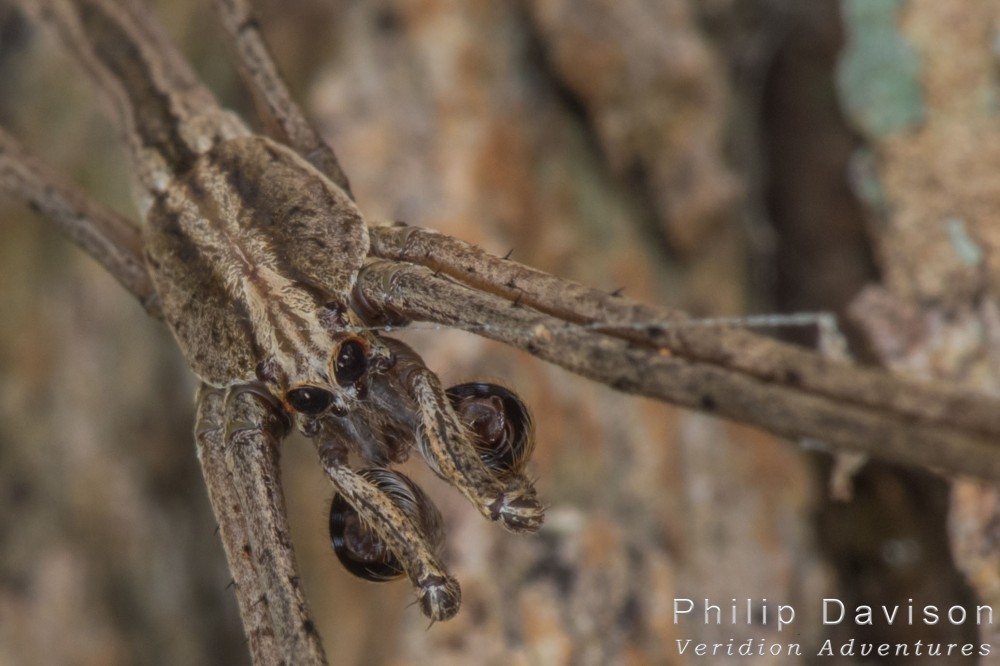
Now you can see those eyes and the features that give it the name; Ogre-faced Spider
Weirdness on the Web
It has been a spidery kind of week. When I was out walking the trails I noticed a small web strung across the path with what I first thought was a small spider removing the papery veil of a Jacaranda seed that had landed there. In the past I have seen various orb-weavers cutting the silk securing an unrequired piece of material that had land in the web, hold it out with their legs until free of the web and let it drop to the ground. Not too far down the same trail I saw a similar thing so I decided to take a closer look. The spider itself was very small and with the naked eye it looked strange, I had not seen this species before and could not quite make out the form. Something just wasn’t right.
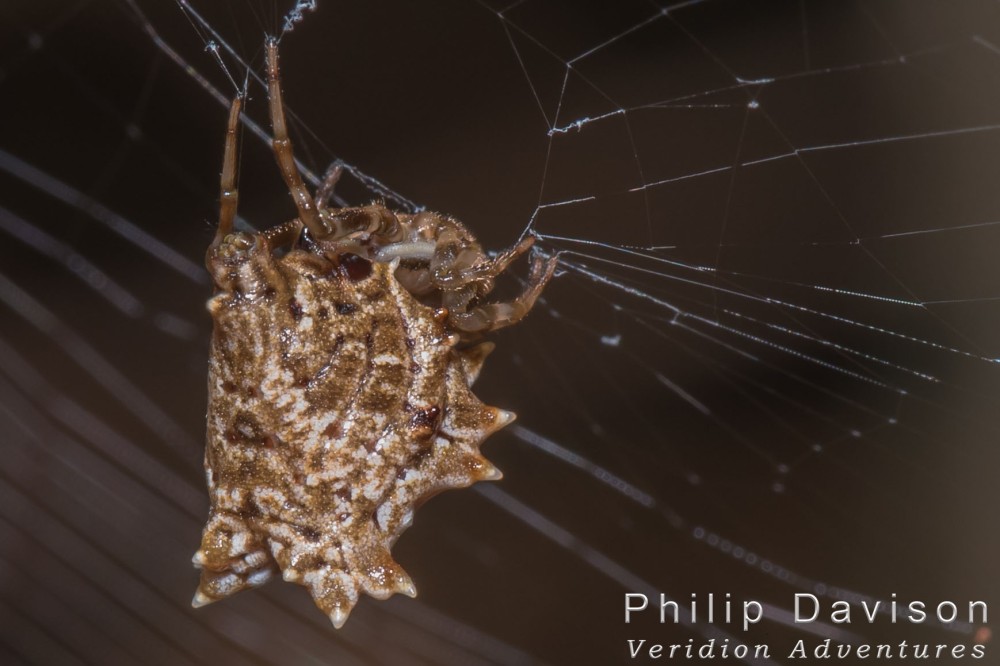
Spiny Micrathena hanging from web, viewed from behind
I took several photographs and looked on the camera screen. The body of the spider was unlike any I had previously seen. The abdomen, (opisthosoma), was drawn up dorsally and expanded laterally. It was covered in a series of fleshy, thorn-like protuberances. I was looking at a Spined Micrathena, (Micrathena gracilis). During the course of the day I found 3 of these spiders, which is strange because I had never seen this species before. Later, when back online and researching more information, I learned it is quite common and widespread. Oh well, new for me and happy to have finally made its acquaintance.
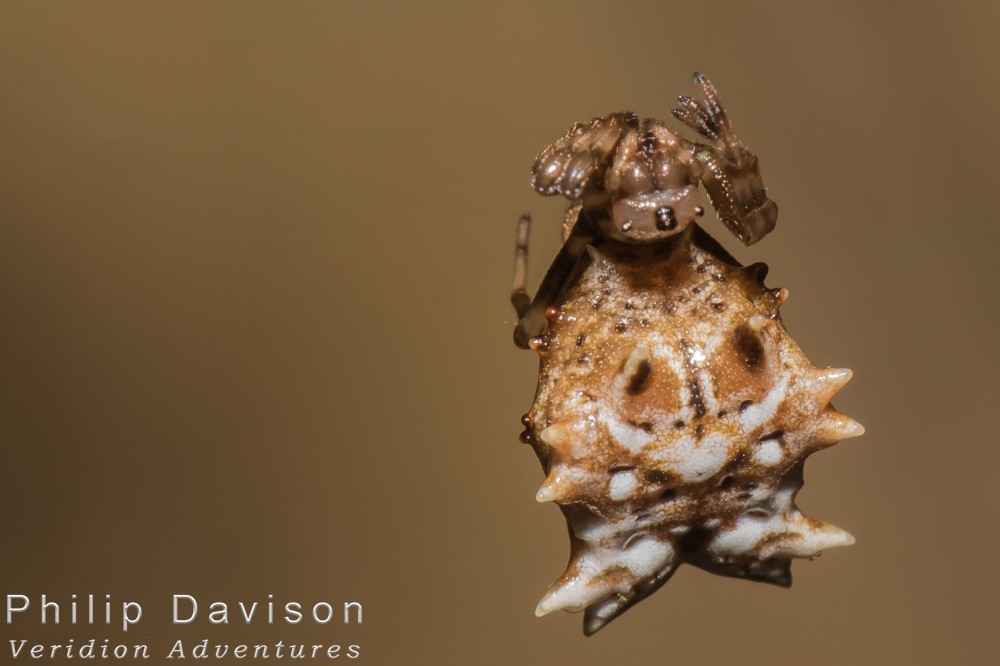
Dorsal view of Spiny Micrathena Spider
Only a few meters down the trail from where I photographed the Spined Micrathena I found another web traversing the path at about 6 feet above the ground. Sitting in the center was yet one more spider that I was unfamiliar with. I knew it was one of the Spiny-bodied Spiders, of which I have found a variety of different species over the years. Unlike Micrathena gracilis above, most Spiny-bodied Spiders are brightly colored and elongated with spines and thorns projecting from the body, sometimes giving them an arrow-shape. I knew this was a Micrathena, the body was long with black centered red spots on a yellow background and with only two more fleshy spines pointing backwards from the abdomen. Extensive searching failed to produce a name for this species. So two new spiders in one day and within several feet of each other.

Strange Spiny-bodied Spider, (Micrathena sp), awaiting identification
Finally I noticed a small web strung not too far above my head in the open garden area. In the center of the web was a small brightly-colored but very distinctively spider. The abdomen was vivid lemon yellow with a series of black spots drawn out sideways into an oval shape bearing ferocious looking thorns around the edge. This was another Spiny-bodied Spider, (Gasteracantha cancriformis).
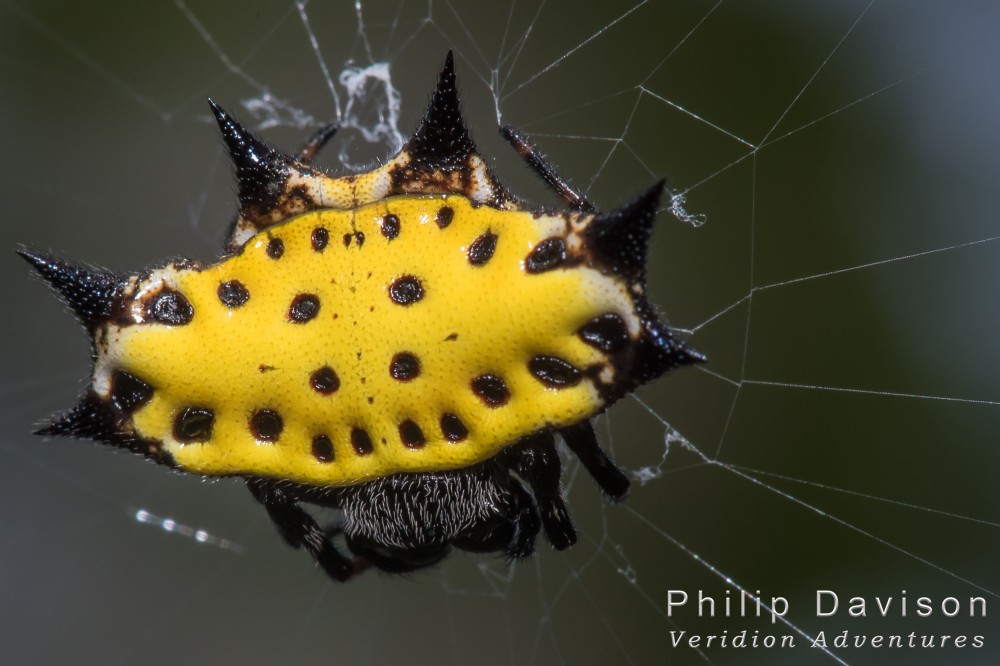
Spiny-bodied Spider, (Gasteracantha cancriformis)
They are a very common species but are so small that you generally don’t notice them until you walk into the web. To avoid this situation the silken strands securing the web are flocked with fluffy pieces of silk to make it more obvious to larger creatures. They come in various color, yellow, white and red being the commonest. They are very widespread, being found from southern U.S. to northern Brazil and everywhere in-between including the Caribbean Islands.
It is a very short-lived spider; the females die after producing an egg cocoon and the males die a short time after mating. In certain locations it is another spider that has a reputation it does not deserve. Some of the native populations regard it as being very venomous. It is quite harmless.
Philip Davison Is a Biologist, Writer and Photographer Based in Costa Rica

It has been another week of sunny days and rainy nights. Last month the immediate area experienced almost 28 inches, (706 mm), of rain. That is approximately 1 inch per day. However, as to be expected, the pattern of precipitation was not that evenly spread. There were several nights with really heavy downpours which accounted for a third of the total. There were more nights when it rained hard but not in a deluge and then there were nights when there was no rain.
Atop Cabo Matapalo, at 500 feet, (150 m), above sea level, there is little chance of flooding, all the water is runoff. This time of year the ground is saturated so when there is a torrential downpour the water may remain on the surface forming large areas of standing water which quickly drains away. The creek water level is high and rushes down the channels, falling over rapids, cascades and waterfalls and finally flowing into the sea. After a night of very heavy rainfall, the creek will have turned murky brown with the volume of sediment it is carrying. Given a few days of sun the water will have returned to its crystal-clear state, inviting you to plunge into its cooling depths as a relief from the hot and humid atmosphere of the forest.
A Typical Rainy Season Day In The Forest
You wake in the morning, opening your eyes but still not fully conscious. You had a good night’s sleep, restful and undisturbed, but were brought out of your slumber by a distant roaring sound. It is still dark outside so what time is it? Early, pre-dawn, and the roar is heard again, this time joined seconds later by a response, louder roaring but much closer to your cabin. All of a sudden the roars are echoing around the forest. To many, the first-time visitors to a Central American rainforest, this could only be large ferocious beasts gathering to collectively do you harm. To the more savvy, seasoned visitor this is a familiar wake-up alarm call, Howler Monkeys, announcing their location to one another so that different troops can keep their distance during the course of the day.
It did its job as far as you are concerned, you are now fully awake. The first light of dawn starts to brighten the sky, throwing the form of the trees into dark silhouettes. Here you are only 8⁰ north of the equator so the dawn twilight does not last for long. The sun rises rapidly and the grey sky turns blue. The birds are awake now. Flying overhead are noisy macaws and parrots heading off from their roosts to the feeding grounds. Their squawking and screeching is not the most melodious of avian calls. From within the forest the Chestnut-backed Antbird, Black-hooded Antshrike and the Bright-rumped Atilla are some of the first choristers to greet the new day. The males are vocally drawing up the bounds of their territories.
It is after breakfast and the sun is now high in the azure sky. The temperatures have rapidly risen from the cool chill from when you opened your eyes. The air is still. You grab your camera and head off into the shade of the forest. The only sound is that of cicadas, their loud calls increasing in intensity, volume and pitch as the morning progresses. Here and there from different points in the unseen depths of the forest, obscured from your vision by the trunks of the trees are more birds calling. The familiar “Who cooks for you” of the Short-billed pigeon, the high-pitched squeaky call of the Black-mandibled Toucan, it sounds more like a rusty pulley that needs oiling than the call of a bird.
You see many things close at hand to photograph, flowers, fruit, a beetle, a praying mantis, small frogs and lizards. Up above you the Spider Monkeys put on an impressive display of acrobatics as they swing through the tree tops. You can’t miss Spider Monkeys with their high-pitched chattering and high-energy crashing through the tree tops. This is in complete contrast to the languid slow moving and deeply voiced Howler Monkeys. You come across a troop of White-faced Monkeys, more leisurely in their pursuit of a meal. You see them peeling away bark and turning leaves, always gleaning, looking for the small creatures that make up the bulk of their diet.
It is approaching midday. The sun is directly overhead. Despite being beneath the shade of the canopy, the temperatures have risen dramatically. Combined with the high humidity, conditions have become like those in a well stoked sauna. If the air was still outside the forest, within its confines there is not a breath of air. The sweat is rolling down your face and your clothes are now soaked. Thankfully you brought a lot of water with you and a packed lunch. Time to take a break for some respite in order to recover you waning energy levels.
As you sit, taking in the sounds around you, a rumbling can be heard off in the distance, thunder. You finish your sandwiches, take a swig of water, pack everything into your bag and head off down the trail once more. You stop to photograph a line of Leaf-cutter Ants. You need to get close to the ground and have some patience to capture the individual caste members. You are rewarded a little later with a swarm of Army Ants, incessant in their drive forward flushing out non-flying arthropods. They are accompanied by a mixed flock of ant-birds, woodpeckers, woodcreepers and Grey-headed Tanagers, all in a heightened state of excitement as they feed on the flying insects driven out of hiding by the Army Ant assassins. Lots of photographic opportunities here.
It is now much later; the almost unbearable temperatures have dropped and the sun is sinking fast towards the western horizon. Also, that rumbling is getting louder and the sky is rapidly darkening in the east. You have filled your memory card with images so it may be astute to pick up the pace now and head back to base. Before too long a breeze picks up and the tree crowns begin to sway. Loose leaves and small twigs come tumbling down from the canopy. It is rapidly darkening and the breeze becomes a wind. The trees are now swaying more violently and you can hear branches being snapped and crashing down. All of the monkeys start to shriek in objection to their homes being shaken in this manner. The advancing storm has no ears and cares not for their protestations. Light rain begins to fall.
Within a shorter time than you would have liked, the sky above you has turned black. The rumbling thunder has become loud and explosive, now accompanied by almost instantaneous flashes of lightning. The rain comes out of the heavens with an ever-increasing intensity. The canopy is being lashed. Leaves and branches are torn from the trees by the sheer weight and force of the water being poured upon them. Lightning is cracking and fissing around you, the storm is immediately overhead, these are thunderflashes and this is not a safe place to be. The path at your feet which moments earlier was soft and damp is now a running river albeit only a couple of inches in depth. The question is should you stop and find shelter or should you persevere on. You chose the latter option.
Your step quickens, not too fast as you don’t want to slip and fall. You hear a sharp crack above you, then a loud snap and a huge branch comes tumbling with force through the understory. It hits the ground so hard that it stands upright as if it had been planted. The flashes are lighting up the whole sky in a blinding white light. Each boom of thunder causes you to flinch. It is raining so heavily that you can barely open your eyes due to the stinging pain it causes you. But you are almost there, the path out of the forest is up some stairs and around a bend on the trail. The steps are now a series of cascades but the tumbling water does not hinder your stride. You will soon be back in the dry comfort of your cabin.
Just as you step out of the forest and into the open garden area, the driving rain suddenly subsides to that of a light summer shower. The black sky starts to lighten and the deep rumbles roll off into the distance. Each flicker of lightning is still causing flashes but now over on the horizon. Thankfully you had the foresight to pack all of your equipment into a waterproof camera bag before the deluge descended and it seems to have served its purpose well. The rain becomes drizzle and finally peters out then stops. The sky is now pale grey and the sun sinks to the point where the final rays light up the underside of the clouds in a deep orange. You have just experienced a typical September day in a Costa Rican rainforest.
Beetles Hiding In Clear View
Beetles, there are thousands of species and yet if you go out with the intention of finding them you may become aware very quickly that they are not as obvious as you have thought. Turning over rocks or peeling rotten bark from fallen trees may produce one or two species but nothing in profusion. That is why when I head off into the forest it is never with the purpose of photographing anything specific, not unless I have seen something that I wanted to return to. Some people go out having birds or mammals as their goal, I am always looking for smaller things, as regular readers of the blog will already know. The camera will have my favorite 105mm macro lens attached and will be set to take photos of all manner of mini beasts in darker conditions. The shots will be hand held as I only take the tripod if I have a certain subject in mind.
Last week I found two different species of beetle out in the open aspect of a sunny forest edge. They were in separate locations but within the same area. They were both sitting on top of a leaf, in bright sunshine and would not stay still. I had to keep maneuvering around the subject to try and get a decent image. Every time I had things set, they would turn their backs to me and wander off along the opposite length of the leaf. Finally, after much repositioning, I managed to obtain some acceptable photographs. One of the problems with photographing beetles is the hard, smooth and glossy exoskeleton that many of them have. It reflects the light from the flash gun. To obtain the depth of field that I prefer, with a moving subject I have to use very small apertures and by necessity I need to add extra light with flash.
The first beetle is a Pleasing Fungus Beetle, (Cypherotylus asperus), in the family: Erotylidae. I am not sure why they are pleasing but fungus beetle refers to their main dietary item which may come as no surprise, fungus. The bright red blotches against a black background is aposematic, or warning coloration. If molested or attacked, the Pleasing Fungus Beetle emits a foul-smelling odor that would cause most would be predators to back off.

Pleasing Fungus Beetle, (Cypherotylus asperus)
The second beetle is a Leaf Beetle in the family: Chrysomelidae. They typically have the domed body, clubbed antennae and are multi-colored. But as there are almost 50,000 species in this family I have, so far, been stumped as to which species this is. Should any beetle expert be reading this and would like to provide a name I would be most grateful. The clue to the diet is once more in the name. They feed on the leaves of a variety of vegetation.

Leaf Beetle, (Chrysomelidae sp)
The Earth Moved
Walking through the forest you can often have your attention momentarily attracted by some small movement down in the leaf litter. It may be ants, spiders, lizards, frogs or a myriad of other small creatures that live concealed beneath the carpet of rotting leaves. It is the tread of your footfall that will disturb them and have them run for cover out of harm’s way. Depending on the speed of the animal you may lose sight of it very quickly. Some move from leaf to leaf. Generally if any of these litter living denizens gets below the leaves it will be gone and unless you are lucky you will just have to imagine what you saw. Occasionally though one will freeze when exposed to the light. Last week, my size 13 boot thudding into the ground caused a tiny frog to jump out of the imminent descending disaster.
There are several small frogs that inhabit the dark and damp environment of the forest floor. The squat body shape of this one revealed its identity almost immediately. It was one of the rather delightfully named dirt frogs, this one being a Stejneger’s Dirt Frog, (Craugastor stejnegerianus).
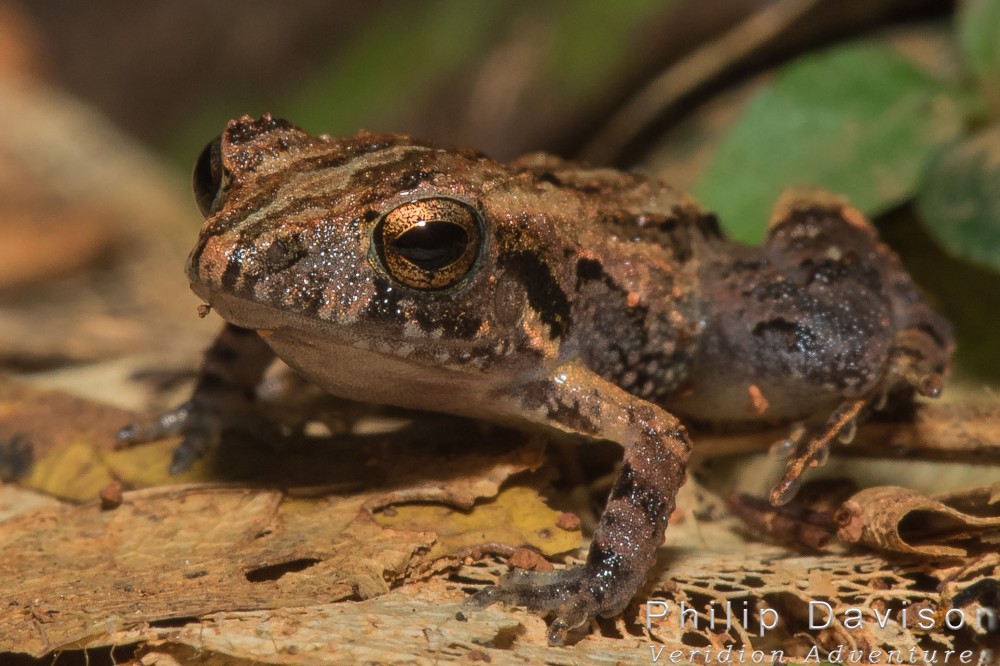
A tiny Stejneger’s Dirt Frog, (Craugastor stejnegerianus)
The dirt frogs are totally terrestrial frogs, they live their whole life on the forest floor and never need to go to water as many amphibians do. They still have moist skins through which they largely breath and therefore by necessity can’t leave the confines of the damp environment under the trees. There are several species that live in this area and Stejneger’s Dirt Frog is one of the commonest.
They belong to the family: Craugastoridae or the Fleshbelly Frogs. Typical of this family is the reproductive habit of direct development which negates the necessity of them having to return to water to reproduce. The frogs pair up, (I can’t say I have ever heard these frogs calling), and the female lays her eggs amongst the leaf litter on the forest floor. There are only about 20 – 30 eggs but they are fairly large in comparison to the adults. The egg is packed with yolk and the tadpole develops within the egg, there is no free-swimming tadpole stage. After about 8 weeks a tiny copy of the adult emerges.
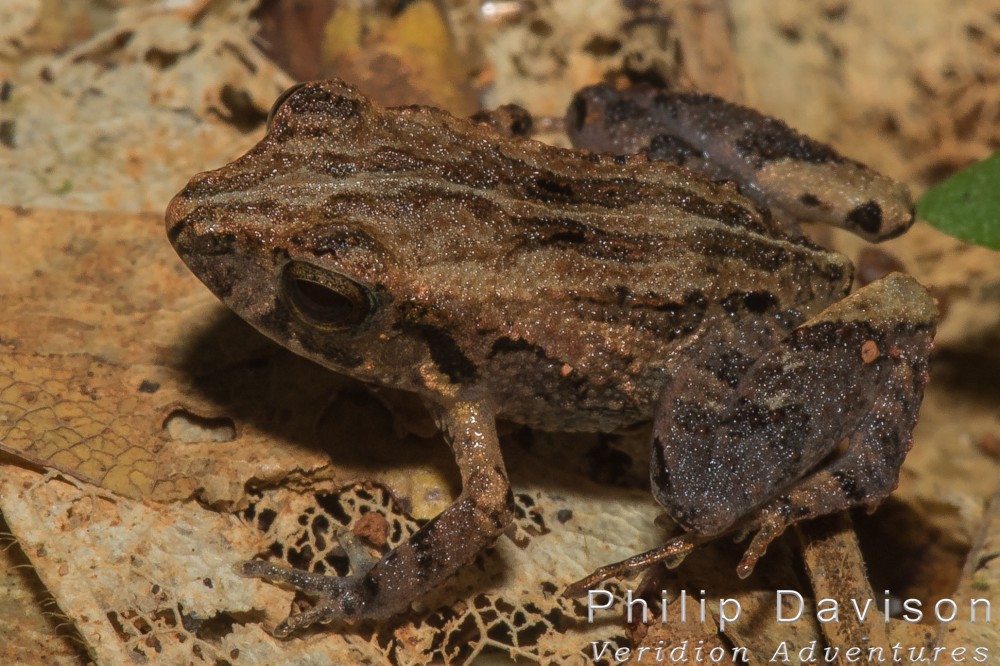
Dorsal view of Stejneger’s Dirt Frog, (Craugastor stejnegerianus)
As you are walking through the forest, if you keep your gaze lowered scanning the ground then you will surely see a small piece of the earth move. Given closer inspection then you will probably find you are looking at a dirt frog. But take a photograph as they are not always easy to identify.
Fying Dragons.
A few weeks ago I managed to photograph a dragonfly with black bases to the wings, a Black-winged Dragonlet, (Erythrodiplax funerea). This week I managed to capture another dragonfly but with the inverse situation of having black tips to the wings, the Large Woodskimmer, (Uracis fastigiata). This one was found in a different area to the previously mentioned species but they had been there for several weeks. This species was found in secondary forest, in a light gap and always close to the ground. Once again my attempts to take a picture were always doomed to failure because every time I lifted the camera to my eye, they would fly off. But as we know with photography patience is a virtue and finally after several weeks I got lucky. This one stayed still long enough for me to get several pictures.
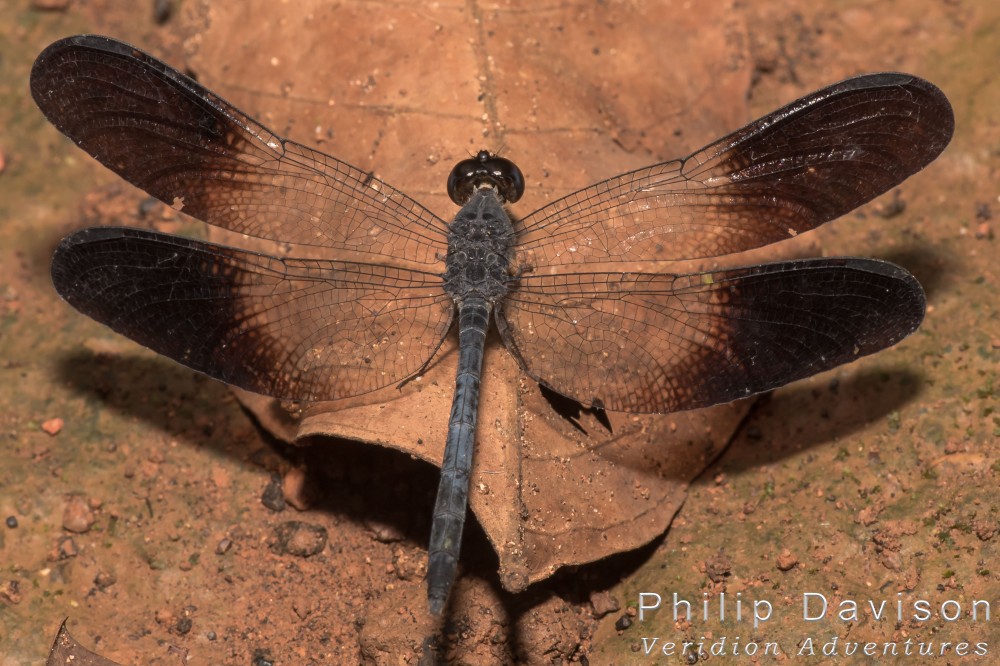
Large Woodskimmer, (Uracis fatigiata)
Unlike the dragonflies which can be found in open sunny locations around a body of water that have fast flight and hover, these forest species seem to be more sedentary and perch on low vegetation and only seem to move if disturbed. Having excellent eyesight adapted to detect movement it does not take much to disturb them. It could be that they are sit and wait predators just diligently watching for the right sized meal to pass by before taking off to capture it.
Philip Davison Is a Biologist, Writer and Photographer Based in Costa Rica

The weather on Cabo Matapalo continues to favor the visitor. Over the past week the days have been dry and sunny, there has been little rain at all. The rain that has fallen has been at night after everyone has returned to the comfort of their cabins. There was one afternoon when an electric storm developed over the tip the tip of the peninsula. Thunder echoed loudly throughout the forest, the rumbles seemingly shaking the ground beneath your feet, whilst simultaneously lightning sizzled and cracked overhead illuminating the surrounding area with blinding flashes of light. The rain poured vertically down from the heavens and within no time the paths had turned into running rivers. The whole event lasted little more than an hour and ended as abruptly as it began. The thunder rolled off into the distance, a herald of the deluge that was about to be visited upon the neighboring areas.
There would appear to be no letup in the enthusiasm of the breeding amphibians. Each night the number of calling males remains constant. The vegetation around the pond is covered in the eggs of many species. It is strange that this year should have seen a surge in the population of Small-headed Frogs, (Dendropsophus microcephala), which previously have been present in small numbers but this year have exploded to the point where they are the most vocal of nightly serenaders.
This has also been an exceptional year for the White-nosed Coatis, (Nasua narica). They are normally to be found around the gardens and throughout the forest and therefore are easily encountered. One of the first animals people see upon arrival are the coatis with their striped tails, slightly curved at the tip, stuck directly up in the air. The males are solitary and tend to bolder in their approach to people. The females, which band together in large groups with the young, until recently were more shy and retiring, they would run if you got too close. At least that is how it used to be. Now they are not so inclined to move out of the way. They will look at you with furtive glances, on their toes ready to run if you make a fast movement towards them, but if you move slowly they will continue about their business just maintaining a wary watch. It could well be that after so many years of being watched in this fashion that they have become familiarized with their human observers and no longer perceive them as an immediate threat.
A Touch Too Much
The sun is setting, its last red glowing rays now only picking out the top of the trees, creating the illusion that the canopy is on fire. You grab your flashlight knowing that the fire will rapidly fade into the burnt-out embers of dark red and ultimately dampened into darkness. With this darkness an awakening occurs, creatures of the night are beginning to emerge. Before all becomes blackness, the silhouettes of bats can be seen against the sky, leaving their daytime roosts to feed on all manner of food. Here the bats feast on a sumptuous banquet, each of the 80 species on the Osa Peninsula having its own preferred diet. There are insectivorous bats, nectar-feeding bats, fruit-eating bats, carnivorous bats, fish-eating bats and yes, even blood-feeding bats, the vampires.
In the background, the plaintive whistle of a Great Tinamou can be heard, its three ascending sad notes announce that the day has ended and the night has begun. As if on a collective cue, the insects start to call. The soft but rhythmic pulsating sound of katydids and crickets fills the still nighttime air. The shrill call of parrots and macaws fill the darkening sky as they pass overhead returning to their nightly roosts. Now, adding to the white noise of the insect symphony comes the call of the amphibians. They have been tucked away, hidden during the day from the harsh and drying effects of the sun’s rays, not good for creatures that breath through a delicate moist skin. But as the air cools it becomes damper, perfect for males to begin to emerge, set up a territorial platform and start to call. If he is lucky, a female will be attracted to the tone of his voice, oblivious to our ears, but sweet music to hers conveying the potential genetic quality that she would wish for her offspring. Finally the deep roars from the male Howler Monkeys as they settle down for the evening are telling you it is time to venture out.
You step out into the darkness, flashlight up by your eye scanning the area immediately in front of you looking for eyeshine. You are familiar with the various colors and the distinctive way the eyes of different animals reflect back at you. There is something. Fiery orange eyes on the ground, it blinks so it is not a snake, it hops up and down and then it calls and flies off. That you could identify quite easily as one of the nighthawks, a Common Paureque, (Nyctidromus albicollis). Now over there in a tree, more bright orange eyes staring down at you. You walk over to see what might be observing you. Before you get close enough to make out its form it calls, a Spectacled owl. It opens its wings, leans into the night and silently slips away, gliding like a feathered phantom into the blackness. So not a bad start to the evening.
There are diamonds sparkling everywhere, on the ground, in the vegetation, all colors, red, orange silver, green and blue. Anything with a diamond sparkle eyeshine you know is a spider and there are hundreds, no thousands of spiders, in whichever direction you look. Most of them are little more than the size of a pinhead.
Your free hand is resting on the low branch of a tree sticking out horizontally from the trunk at about hip level. You are glaring into the tangled vegetation in front of you looking for some of the amphibian choristers that you hear calling when you feel something lightly brush against your hand. You don’t retract you grasp quickly but rather gingerly lift your hand away and turn the flashlight in the direction of where it was resting. There you see the creature that had inadvertently made contact with you before withdrawing. Its body is large and hairy, it has eight stout and hirsute legs. Your pulse races and a bead of sweat rolls down by your eye from your brow. It could be due to the heat of the night but it is probably because you are looking at a tarantula.
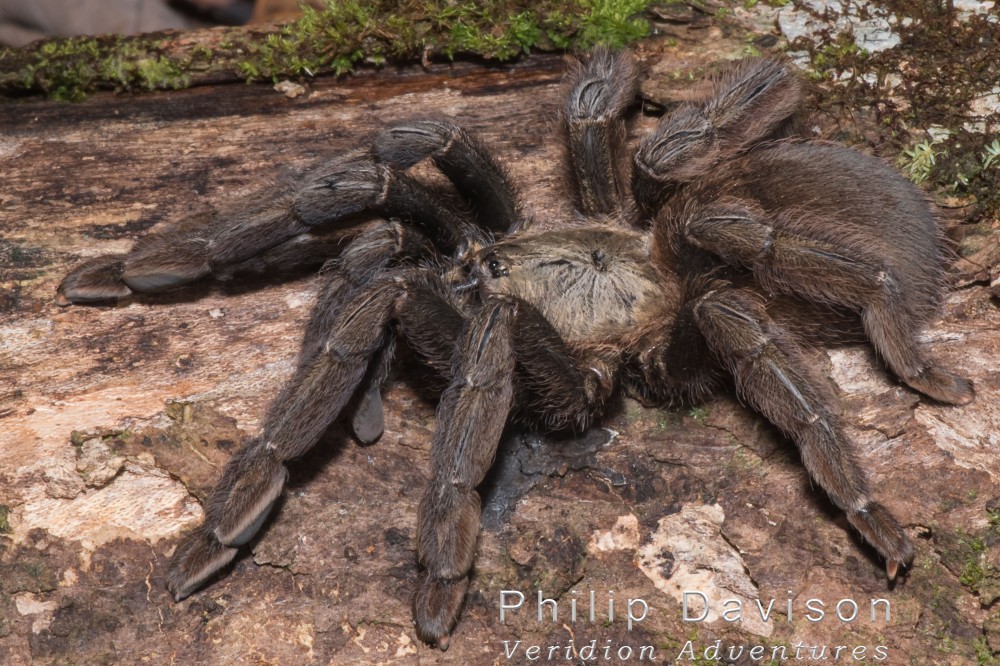
Unidentified Tarantula species in the Costa Rican rainforest
Tarantulas And The Dance Of Death
Now mistakenly putting your hand on a tarantula in the dark would increase the heart rate of most people but like so many other maligned creatures, the poor tarantula has a reputation it does not deserve and nor can it live up to. Despite their size and grotesquely fearsome appearance, tarantulas are shy and mostly harmless creatures. They are however venomous and a large, hairy, many-legged venomous arthropod is generally going to suffer bad press amongst their misinformed human observers.

A rather shy Tarantula does not want its picture taken
Venom is a complex cocktail and quite often it can be very different and peculiar to different types of spiders depending upon their preferred dietary prey species. Once a spider catches its prey, the victim must be rendered immobile very rapidly, especially if it is not caught in a web and then swaddled in restraining silk. Most venoms therefore contain fast-acting metabolic toxins that kill or paralyze the prey rapidly. In this respect, tarantula venom is very weak and does not have much effect on humans but it will kill dogs. Spiders do not have mouthparts capable of mastication so essentially they have to drink soup, that soup being the digested internal organs of their prey. The venom contains proteolytic enzymes that break down and liquidize the tissues so that the spider can suck up the rich protein meal and finish the process of digestion within its own alimentary canal.
So why does the tarantula have a reputation of being so dangerous. The story has its origins in a city located in mediaeval southern Italy called Taranto. Here lives a wolf spider, (Lycosa tarantula), one bite from which would drive the victim into a state of frenzied madness more commonly known as tarantism. The unfortunate sufferer was prone to dizziness, vomiting and a heightened sensitivity that compelled them to lose all inhibitions and dance in a wild state of abandon trying to release themselves from the effects of the venom.
Due to these effects, it has been suggested that the spider responsible was Latrodectus tresdecimguttatus, closely related to Black Widow of the U.S.A and the Red-back Spider of Australia. It may well have been that in a mediaeval Italy gripped by religious fervor that most cases of tarantism were little more than the result of a pious mass hysteria and not a spider induced dance of death. However the story travelled with European settlers to tropical America and from thereon the poor tarantula was saddled with the name and its resulting reputation from its smaller, deadlier European cousins.
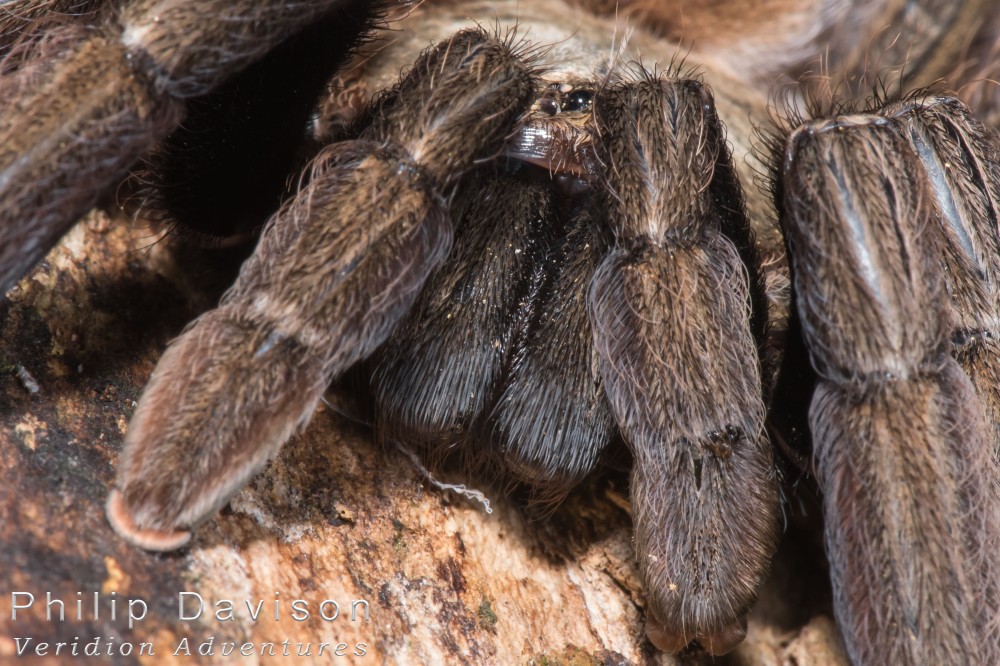
Tarantula sp – look closely and you can see the fang-tipped chelicerae
The tarantula in these photographs was found last week on the grounds here. It was not very co-operative and shied away from having its picture taken. When I tried to get a close-up on the fangs, it pulled all of its legs up against the body. I did manage to get low down and in front to get an image that if you look closely reveals the two fangs, which in the case of tarantulas are parallel to each other and face forwards.
Small But Deadly
Talking of smaller spiders, there is one species I see commonly around the buildings of the area that could be quite easy to miss. It prefers dark corners where two walls meet at right-angles. It is dark ruddy-brown and spends the day with its legs tucked up under the body. The web is little more than a few silken strands strung between the two wall faces. What draws your attention is not the spider itself but the size of prey it captures and consumes. I quite regularly see everything from large kaydids, beetles and moths dangling helplessly from the sticky diaphanous cords as a tiny spider cautiously approaches to deliver the coup de grace.
Although I do not profess to being an expert with regards to spiders, (nor with anything in fact), I think these tiny assassins belong to the family: Theridiidae, which includes the notorious Black Widow, (Lacrodectus mactans). The venom of the spiders in this family is highly neurotoxic which would explain why prey so much larger than the spider rapidly succumb to its bite. I don’t know anyone who has been bitten by one of these individuals I commonly find lurking in places like bathrooms and have no great desire to try and find out for myself.
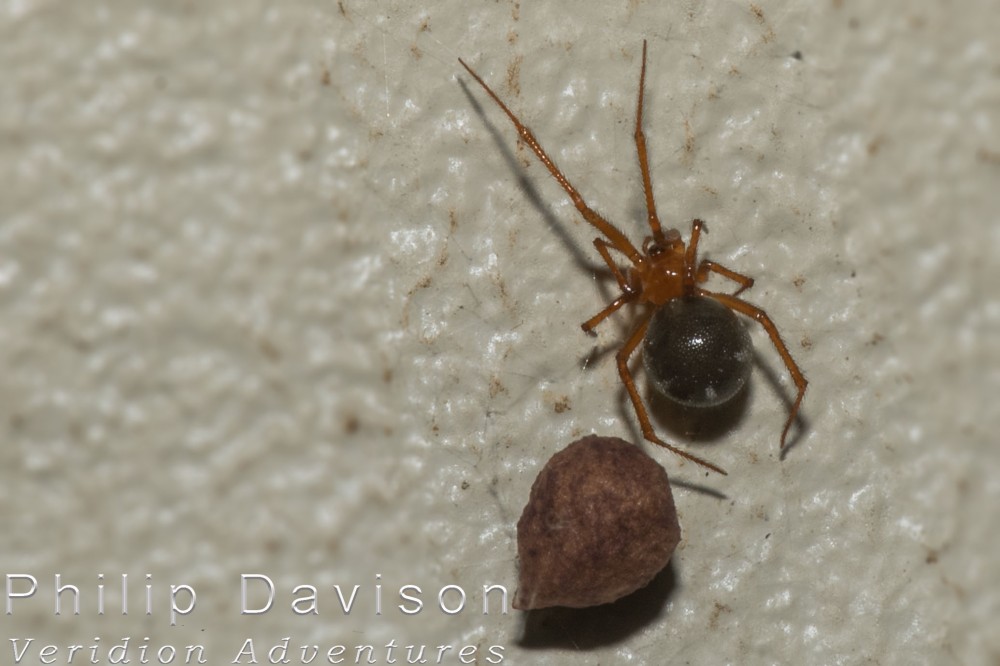
Tangle-web Spider female guarding egg cocoon
The individual in the photograph sat guarding a grey sac for many days. This is the egg cocoon. She will mate with a male then lay her eggs which she will wrap in silk in order to protect them against the environment and parasites. When these ones hatched I would see them swarming all over a prey item along with the mother. I never saw her wrap a victim in silk, they just remained suspended in death pose from the strands upon which they had initially and unfortunately become caught.
Choking On A Poisoned Thorn
One more spider that I found last week in the gardens is so distinctive that it can be identified immediately, at least to genus level. This is one of the Spiny-bodied Spiders, (Micrathena sp). They are small but tend to be dressed in bright and contrasting colors so you should not have too much trouble finding them if you are diligent in your searching. They are orb-weavers but the web, just as its maker, is relatively small. Spiny-bodied Spiders are more commonly found in the open areas rather that within the depths of the forest. Their webs can be found strung between the twigs and branches of bushes and small trees.
Once you have located one of the Spiny-bodied Spiders you will quickly appreciate why is bears that name. The rear of the abdomen is drawn out into two long vicious-looking thorns at the base of which are two shorter spines. The dorsal surface of the abdomen has a pair of upward pointing spines while the ventral surface has one downward pointing spike. This whole appearance is not an appetizing prospect for a potential predator. The coloration of bright vivid primary colors against darker background colors actually make the spider stand out in contrast to its surroundings. If it is visibly obvious then it is patently not trying to hide. It is using warning, (aposomatic), coloration to advertise its presence to a predator.
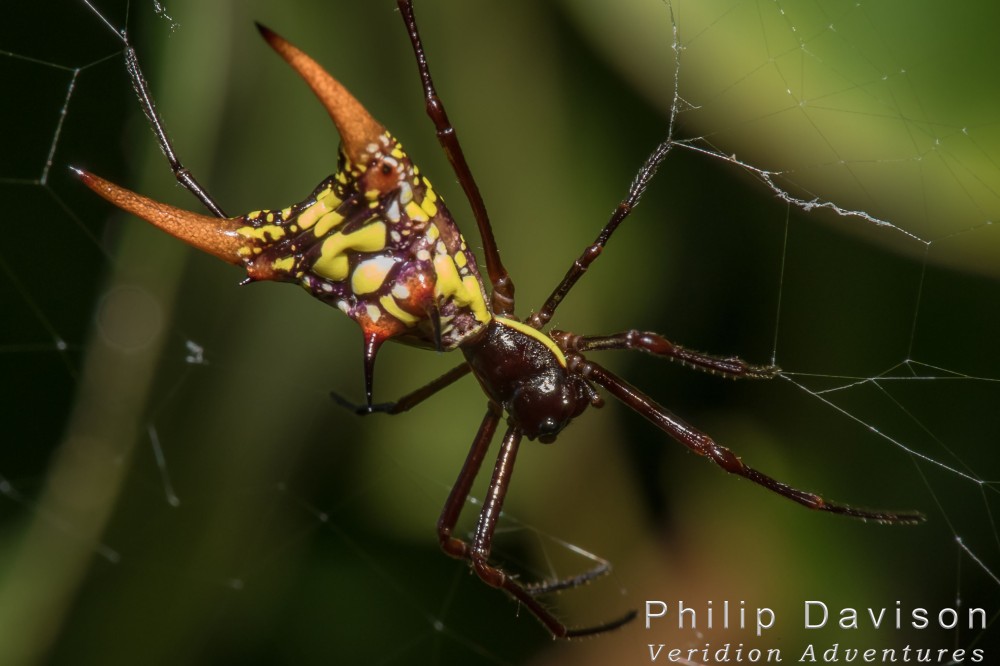
The spines covering its body are a clue to the naming of the Spiny-bodied Spider, (Micrathena sp)
Should a naïve predator such as a bird or lizard ignore that warning signal and try to feed on the spider, those thorns and spines will lodge it in the unfortunate creature’s mouth from which it is very difficult to displace. The spider meanwhile produces a noxious secretion that tastes foul and the hapless predator, rather than relishing a tasty meal, is now stuck with spiny vile dietary experience. One the spider is dislodged, the predator will never, ever go near anything sporting aposomatic colors again.
Shadowy Parasites – Not Green And Not Seen
While walking the trails I found a weird little plant that could easily be mistaken for a fungal fruiting body. It grows from the ground with a short fleshy stalk holding up the flowering head. The overall color is the same as the ground, a ruddy-brown, there is no green to be seen. In appearance it looks like no other flowering plant. It contains no chlorophyll because it is an obligative parasite. It taps into the roots of trees from where it extracts all its nutritional requirements. This is Helosis cayennensis of the family: Balanophoraceae. They can be found in northern and southern hemisphere tropics.

Strange acorn-shaped inflorescence of Helosis cayennensis
The main body of the plant is an amorphous underground tuber attached to the root it is parasitizing. The flower head produces both male and female flowers both of which are small in size. Quite often they can be found in large clusters, especially this time of year, the wet season, growing out from the base of the tree they are sucking the life from.

No green to be seen – the parasitic Helosis cayennensis
Philip Davison Is a Biologist, Writer and Photographer Based in Costa Rica

Transition, that is what is occurring now. The days remain largely sunny but the rain has started to increase in volume, intensity and duration at night. The creek running through the area is always a good yardstick by which to measure how dry the ground is. This year the creek never dried up and as of this week the flow is fast and the level high. The small cascades along its course are looking very picturesque with the water tumbling from higher to lower levels into the plunge pools, babbling softly as it does so and sounding like playful water nymphs inviting you to join them and cool off in the heat of the day. The water here is clean and crystal clear, its depth holds no latent or potential disease and the only animal life is the occasional sighting of a tropical crayfish hidden beneath a submerged rock, its bright blue body being visible to only those with the keenest eyes.
The Puma, (Puma concolor), has been seen again and its tracks could be found on several trails around the grounds. The past week has also been a good one for seeing the Squirrel Monkeys which are normally a little more retiring living as they do in the thickets of secondary forest. At the moment they have been making daily excursions in large numbers through the gardened areas.
The repetitive call of the Bright-rumped Atilla, (Attila spadiceus), had fallen silent for some months but once again they have started up and bursts of “Read it, read it, read it, read it” can be heard again echoing around the trails in the early morning. The frog breeding season normally starts with the first rains in May and then by the end of July it is over. Not this year. Every evening, just after sunset, the various species of amphibian emerge en masse, the males begin to call for a mate and by next morning the vegetation on and around the pond is covered in frog’s eggs.
Armored Four Sight
It is dark in the forest. You can’t see much. Your flashlight illuminates the path in front of you but the beam does not penetrate very far into the blackness and it also casts deep shadows. There is something moving in those shadows. You stop and listen. It is not something small. You shine the flashlight in the direction of the movement, your eyes peering into the gloom. You still can’t make out any shape but the sound of the creature advances ever closer. It crashes forward a few feet then stops for a moment and then moves again. You can start to see the dead leaves and fallen twigs moving. Your heart is in your mouth, it is almost upon you. Then silence. It is suddenly aware of your presence and it has stopped, motionless, whatever it is probably eyeing you as a meal. Then crash, it takes flight and rushes across the path in front of your feet. No wonder it sounded like a small tank rumbling across the forest floor, it is a mini armored insect feeder, a Nine-banded Armadillo, (Dasypus novemcinctus).
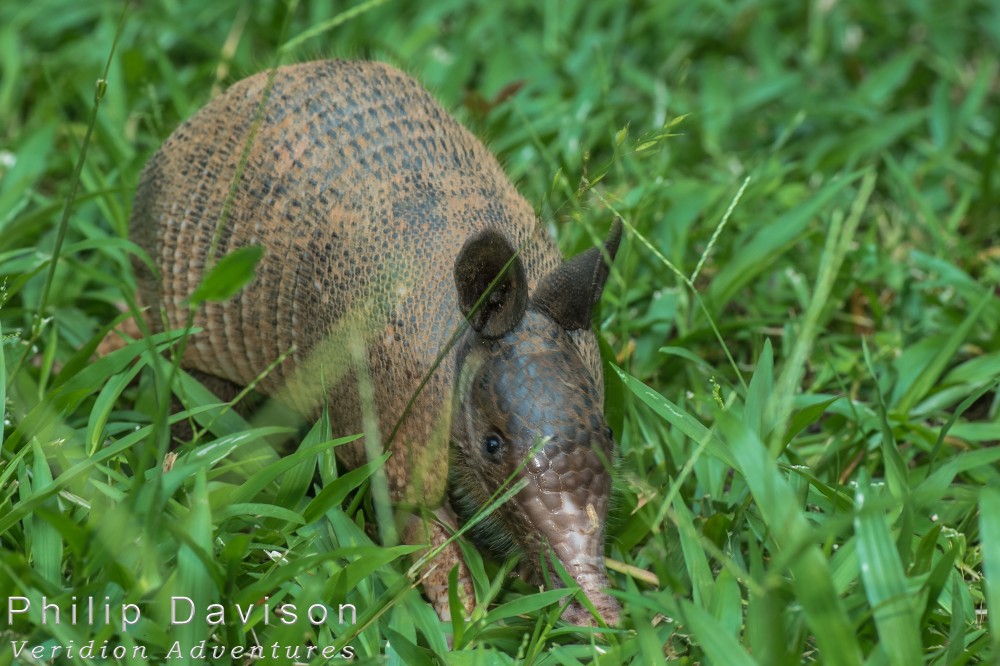
Juvenile Nine-banded Armadillo, (Dasypus novemcinctus), grubbing for food
Armadillos rank alongside sloths as one of the mammals that people would like to see when they visit the forests of the Osa Peninsula. They are not as readily found as the monkeys, agoutis or coatis but they are here and they do show up fairly frequently. They are encountered more commonly at night but it is not unusual to see them trundling around on the ground during the day too.
Armadillos belong in the ancient mammalian order: Xenathra along with anteaters and sloths. Nine-banded Armadillos have a large geographic distribution. They are found from the Southern United States through Central America down into Argentina. Between 4 – 2 million years ago when the southern part of Costa Rica and Panama rose out of the sea to form the land bridge between the North American and South American continents it provided a means by which terrestrial animals could move between the formerly separated land masses. Many northern species moved south and survived. Only three species moved north and survived; opossums, porcupines and the Nine-banded Armadillo. Nine-banded Armadillos have a large geographic distribution. They are found from the Southern United States through Central America down into Argentina.
There is no mistaking an armadillo for any other type of creature. The body is covered in a shell composed of bony plates within a keratinous horny skin. The eyes and ears of an armadillo do not function too well. The long snout provides an excellent sense of smell which is essential in the location of food. The majority of the armadillo’s diet is insects. It has powerful claws which it uses to grub up a variety of ant and termite species from the ground. With the nose stuck in the dirt, an armadillo can hold its breath for upto 6 minutes while it feeds on a particularly good banquet. Those claws also dig out burrows in which the armadillo lives.
Reproductively armadillos are very interesting. The female armadillo can delay implantation of the fertilized egg into the uterine wall if the prevailing weather or feeding conditions are less than optimum for its survival. The egg always divides into four which means that the female armadillo will give birth to four identical quads.
Last week as I headed out for a walk I saw four of these juvenile siblings snuffling their way through the lawn, heads stuck in the ground, turning over the earth in search of a meal. They had absolutely no idea I was there. I took some photos and then lay on the ground to take some photos as they came trundling towards me. It only dawned on them that I was there when one hit the camera. The first defense response of an armadillo is to jump, albeit not too high, and then run off. The first one to make contact with me turned and ran but the others still had no idea of my presence. The adults are no better. I have stood still in the past and had large armadillo running back and forth over my feet. Should anything alarm them and they take flight, their short-term memory is little more than a few seconds before they return about their business as if nothing had happened. I enjoyed watching these youngsters for a while before heading off and leaving them to feed and hopefully avoid coming across something that might not be as benevolent as I was.
All That Glisters
Down amongst the leaf litter a glitter of polished bronze slips under the leaves. As it passes from beneath one leaf to the next you can see a metallic object glinting momentarily before disappearing again. It moved too quickly to truly see what it was but you persist. There it is again. You bend down to move the leaf where it went, but nothing. Then you see it just a hands breadth away. A small head looking at you with intent dark eyes. It is a lizard or more particularly a skink. It is tiny with an elongated body and shiny smooth scales. The scales catch the light and reflect a bright dark copper. You find yourself looking at a Brown Forest Skink, (Sphenomorphus cherriei).
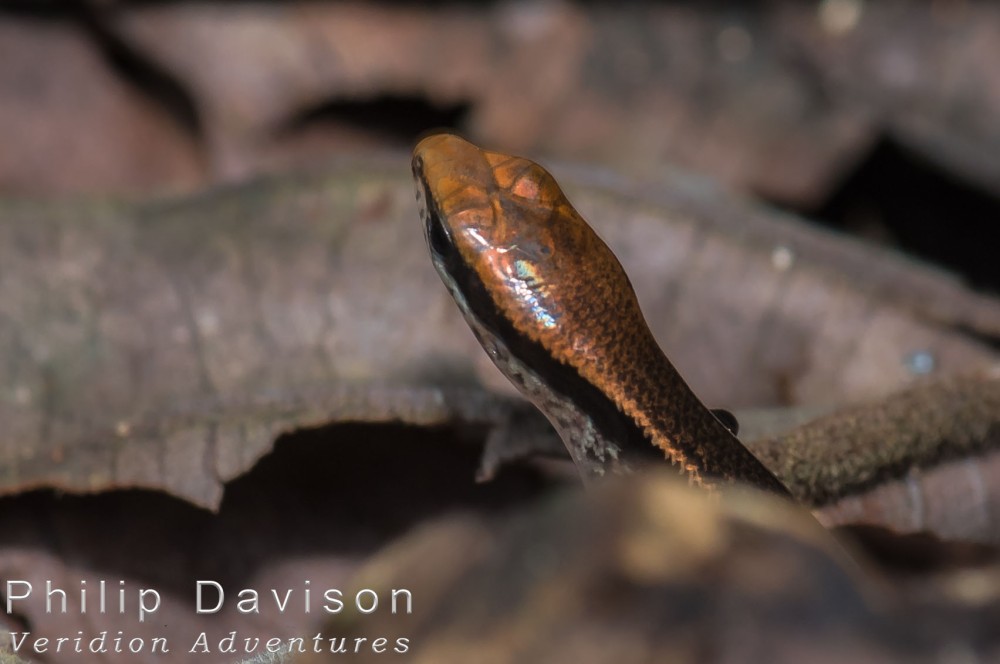
Brown Forest Skink, (Sphenomorphus cherriei), looking out from under a leaf
Several weeks ago I took photos of yet another small leaf litter dwelling lizard, the Northern Spectacled Lizard, (Leposoma southi), and stated that I really wanted to find and photograph the Brown Forest Skink too. It is no easy task as they move quickly and once beneath the leaf litter ‘swim’ in a serpentine fashion through the decomposing vegetative material. This one poked its head out long enough for me to get a quick shot or two. I will have to keep looking to get the full body shot.
The hard and shiny scales of a skink may serve several purposes. They help it glide between the material of the substrate making up the leaf litter in which it lives. But there are lots of birds hopping around close to the forest floor whose keenly acute vision would spot a meal such as skink very quickly. If caught in the bill of an avian predator the scales allow the skink to slip out and hopefully, as far as the skink is concerned, make its escape.
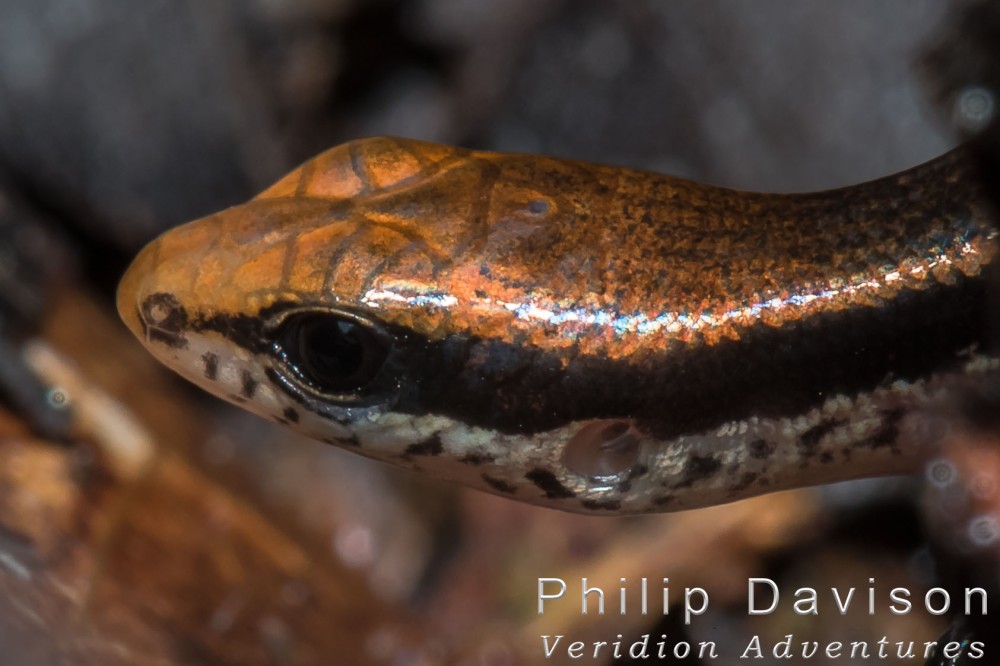
Brown Forest Skink, (Sphenomorphus cherriei), close up of head
Dressed In Black For The Telling Of Dark Tales
Walking on the forest trails you see a something take flight and then settle again on another plant. The overall aspect is of an insect cloaked in funereal colors. The body is black and the wings have black banding. Nonetheless it draws your attention.
The creature is a Black-winged Dragonlet, (Erythrodiplax funeralis), a common dragonfly found inhabiting forest rides or at the edge of open areas. Dragonflies are restless predators. They are on the constant look out for a meal. They are easily disturbed too. Those huge eyes and mobile head can spot a potential predator or prey item very quickly. If it is the former they fly to another perch. The Black-winged Dragonlet has a much more fluttery flight than some other dragonflies which seem to dart back and forth.
They catch their prey on the wing which means they feed on flying insects. Should a meal fly by the dragonfly swoops in and catches in its legs which form an open basket beneath the thorax. The legs are covered in spines which make it difficult for the victim to escape. Once ensnared, the prey will be dispatched, the hard body parts and the wings dumped to the ground and the rest of the body consumed.
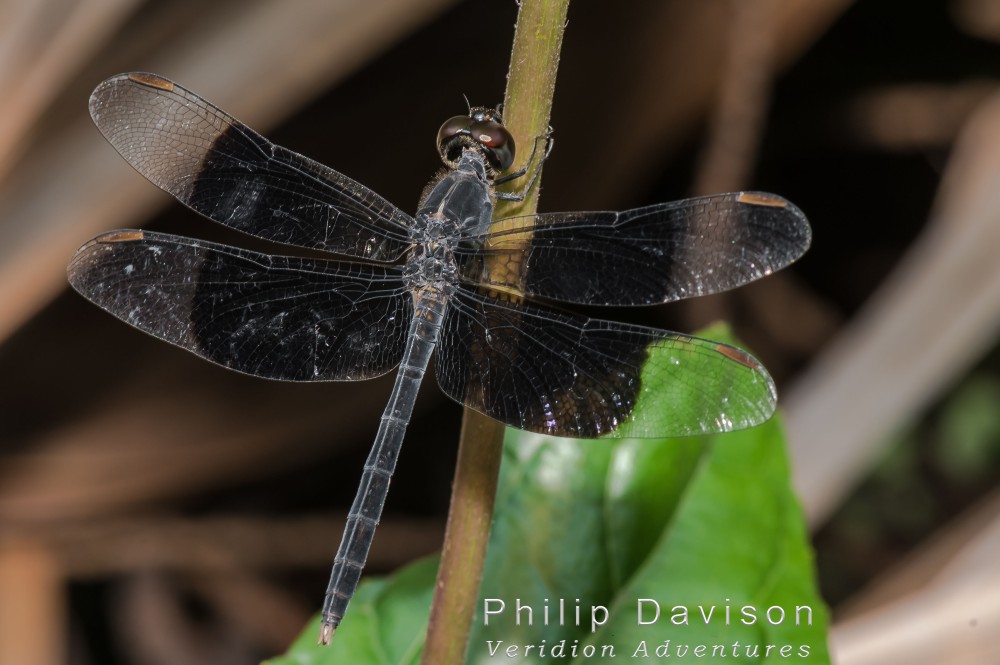
Black-winged Dragonlet, (Erythrodiplax funeralis)
Dragonflies can present a challenge to photograph. They are acutely visually aware, they move quickly and they don’t like being approached. This one I had to follow, very slowly and patiently, before I managed to get a photograph. It did take a good few attempts as it kept moving from perch to perch and I was on the point of giving up when it seemed to settle, at least long enough for me to hit the shutter several times. Anyone out there who has tried photographing flying insects knows that patience is an essential virtue if you are going to obtain any images.
Philip Davison Is a Biologist, Writer and Photographer Based in Costa Rica

Following last week’s heavy rainfall, this week the weather has taken a turn in the opposite direction. We have seen a lot of sun during the day and later as the sun sets clear evenings reveal a sky filled with stars. Each walk through the forest would result in a return to base with your boots heavy with clinging mud. Now the ground is still soft but remains in place and not so much covering your feet.
Normally at this time of year the Osa Peninsula, Costa Rica experiences a brief, but welcome, climatic anomaly known as the “Veranillo’, or little summer. For a two-week period in the middle of the wet season the atmospheric and oceanic currents conspire to produce a situation where the conditions dry up. It is a false dawn giving hope to the ignorant that the wet season is over. In fact it is a prelude for those experienced in reading the signs of what is imminently about to happen, the full wet season is due to be unleashed. But at least we can enjoy a short period of heat and light before enduring three months of daily tropical deluges.
Lazy Cats and Strange Sightings
Last week was exciting for a variety of reasons. One day, late afternoon, a Puma, (Puma concolor), was spotted lying on the ground under a bush just off to the side of the road. Everyone in the near vicinity was alerted and proceeded to congregate in an area where they could safely observe, video and photograph the wild cat. The Puma was fairly unconcerned about the mild disturbance to its siesta and continued its nap.
After a short while, it slowly rose to its feet and walked nonchalantly in front of the audience, not even casting a glance at those desperately attempting to takes its portrait. Everyone’s hearts were now beating heavily in their chests, this was a big cat and it was no more than 30 feet, (10 meters), away. For many people this was a once in a lifetime opportunity and they captured so many excellent images. The cat finally made its way toward some denser vegetation and disappeared into the darkness.
Whereas close proximity to a large wild feline causes a lot of excitement, for most people the sighting of a hitherto unseen butterfly would not. Well, not except for me and one or two others that is. Last week I saw a new butterfly species that I had previously not recorded for the Osa Peninsula. The butterfly was so distinctive ensuring there was no possibility of an incorrect identification. Sadly I did not have my camera in hand so was unable to obtain photographs.
On the day in question, just after lunch I saw a butterfly flying around the garden, not too fast and occasionally landing on the ground. It was not a sight I could miss as the upper surface of the wings had two bright postbox red stripes running over a black background. This contrasted vividly with the green of the grass. I followed the butterfly trying to commit to memory the markings and coloration so that I could remember them later for an identification. I had an inclination of what it might be but just needed to verify it.
A quick look at the excellent reference book, “The Butterflies of Costa Rica” by Philip J. DeVries solved the mystery. The butterfly was a Red Banner, (Temenis pulchra). It ranges from the Amazon Basin and reaches its northern limit of distribution in Costa Rica. This individual was a male, which despite normally only being found at canopy level, will sometimes descend to the ground to visit mammal dung or urine. Whatever it was looking for, I was happy to add one more new species for the ever-increasing inventory for the area.
Blue Bug – The Showdown
This has been a good year for bugs, true bugs. I have managed to photograph a good many species even though I have not been able to put names to them all. There is one that has eluded me though. It is a reasonably common Shield Bug, but for whatever reason I could never find one that would stay still long enough to have a photograph taken or if I did manage to get a shot, the resulting image was not of a usable quality. Last week, all of that changed. I found one that stayed still, at least momentarily. I managed to get several shots, even though it took to the air several times, but it always came back again.

Red-bordered Stink Bug, (Edessa rufomarginata)
This is not a bug that you could easily miss. The upper side of the head, thorax and abdomen are turquoise blue, with bright red edging. The antennae are fire orange. The underside is pale yellow with black stripes and the legs too are orange. There is no mistaking that you are looking at a Red-bordered Stink Bug, (Edessa rufomarginata).
Stink bugs belong in the true bug order: Hemiptera and the family: Pentatomidae. It is a widespread species ranging from Mexico in the north to Argentina in the south. Unfortunately they are a serious pest species on commercially grown species of the plant family: Solanaceae such as potatoes and tobacco, (although some might see destruction of tobacco plants as a good thing).
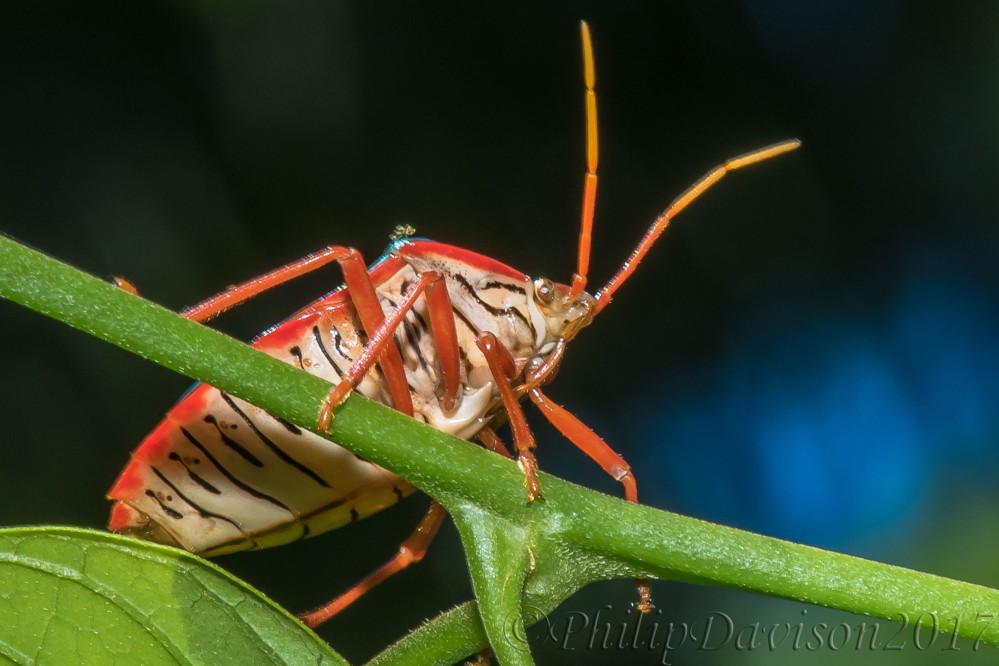
Ventral view of Red-bordered Stink Bug, (Edessa rufomarginata)
Not having a sense of smell, I miss many odors and scents that people find either delightful or repugnant. Stink bugs fall into the latter category. The stench they produce from glands on the abdomen is released in response to being in some way being put under threat. Apparently it smells very strongly of cilantro. But, however the less than pleasant odor smells, I was happy to have finally got my picture.
Milk From a Tree
There is a tree fruiting at the moment whose fruits can be seen lying on the ground at various points around the trails. There are only one or two individuals of this species of tree in this area but the fruits are an obvious indicator of their location. The tree is Palo de Pico, (Naucleopis ulei). The fruit is a small woody sphere of green and yellow coloration covered with softer fleshy finger-like protuberances of the same color.
The tree belongs to the family: Moraceae which is a cosmopolitan family composed of over 1100 species found mainly in the tropics but also in subtropical or even temperate areas around the world. There are 50 different species of Moraceae found on the Osa Peninsula.

The distinctive fruit of Naucleopsis ulei
One of the distinguishing features of many trees in this family is the milky white latex that exudes when they are cut into which gives rise to colloquial names such as Milky Tree, Cow Tree and Rubber Trees. All of these species can be found in the forests of this region.

White latex leaking out of fallen Milky Tree, (Brosimum utile)
One genus in this family that is very important in the forests are the fig trees, Ficus. There are 750 species of Ficus worldwide of which 23 species are found on the Osa Peninsula. Figs are one of the most important species of tree in the forest as they produce a year round supply of copious amounts of fruit. This in turn is important in providing a continuous food supply for so many of the animals in these forests. Significantly, if climatic conditions result in a low crop then so many fruit-eating animals from monkeys to toucans will suffer and may be unable to raise young during that particular year. Strangler figs are also responsible for the taking over and killing some of the more mature trees in a forest community.
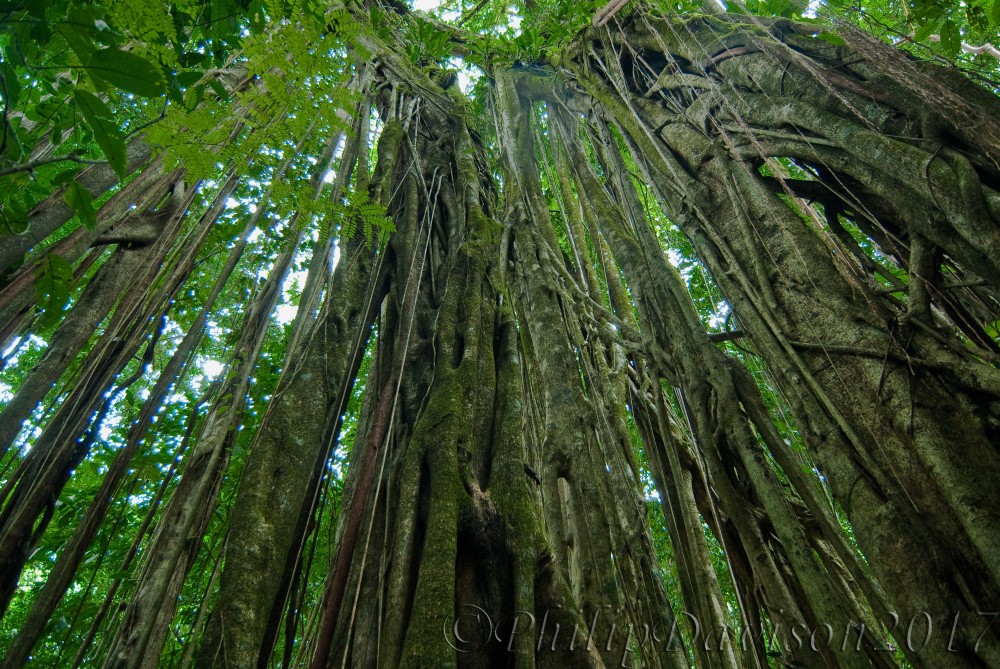
Amazing Strangler Fig, (Ficus zarazalensis), endemic to the Osa Peninsula
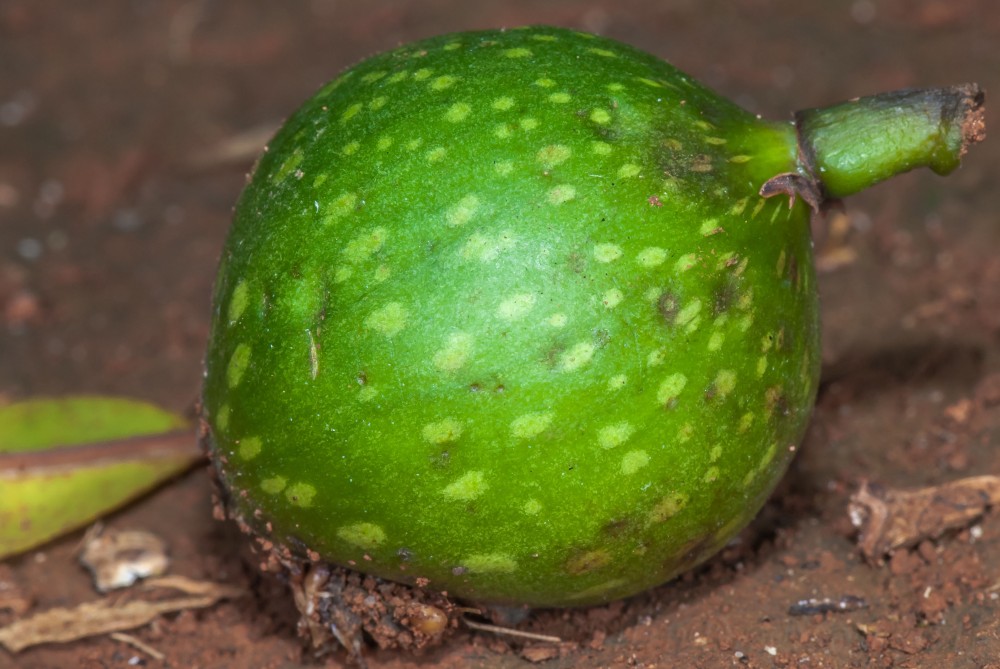
As the name suggests, not such a tasty fig, (Ficus insipida)
Philip Davison Is a Biologist, Writer and Photographer Based in Costa Rica




















































